In Washington State’s northwest corner, Olympic National Park covers almost a million acres of stunning and varied landscapes. Established as a national park in 1938, Olympic offers a special mix of ecosystems. Your family can explore rugged mountains, long stretches of coast, and thick rainforests—all in one park. This area is also rich in Native American history, with tribes like the Quileute, Hoh, and Makah calling it home for thousands of years. For families, Olympic National Park provides an unbeatable opportunity to connect with nature and explore different environments, offering an unforgettable vacation.
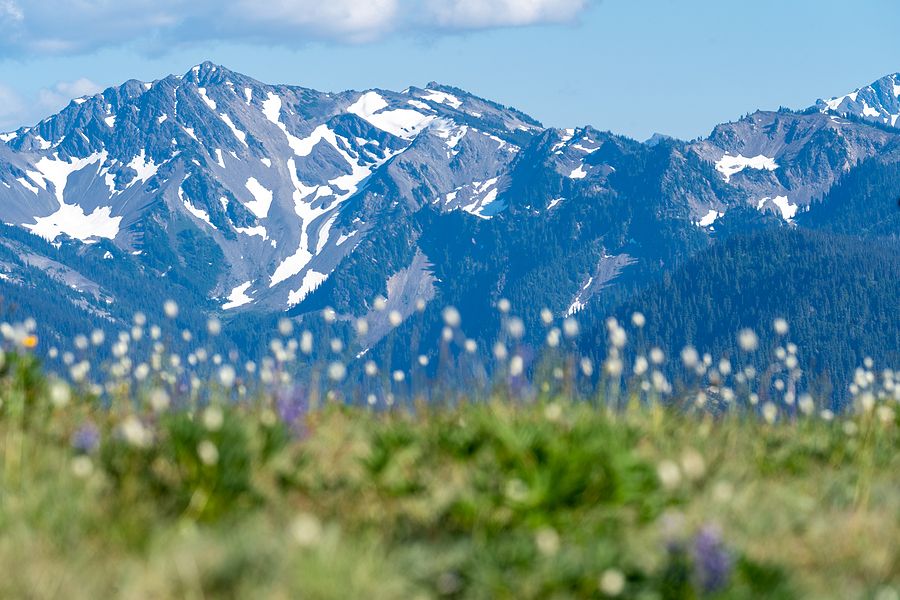
Start planning your family’s trip now. Our guide provides insights on the optimal times for visiting, highlights ten unique areas within the park, and offers valuable tips on accommodations, essential travel pointers, and comprehensive maps to facilitate your planning process.
Our time at Olympic National Park gave us incredible insights, and this guide combines our firsthand experience with in-depth research to help your family explore with ease.
- Navigating Olympic National Park Entrances
- Olympic National Park Entry Fees
- Best Time to Visit Olympic National Park with Kids
- Plan Your Trip with Olympic National Park Visitor Centers and Information
- How to Get Around Olympic National Park
- Explore the 10 Areas of Olympic National Park
- Hiking in the Olympic National Park
- 5-Day Olympic National Park Itinerary with Kids
- Where to Stay in Olympic National Park with a Big Family
- Tips for Planning Your Trip
Navigating Olympic National Park Entrances
Olympic National Park is vast, and gaining access requires planning due to its expansive layout. Encircling most of the park, Highway 101 serves as a primary route, branching into various areas. While numerous sections have ranger stations, only three key entrances require a park pass or entry fee. These are located at Heart O’ the Hills, just five miles south of Port Angeles leading to Hurricane Ridge, Elwha (currently closed), and the Hoh Rain Forest.
Olympic National Park Entry Fees
A standard pass for Olympic is $30 for a 7-day pass or $55 for an annual pass. It’s recommended to purchase an America the Beautiful Pass for $80, granting access to over 2,000 federal recreation sites for a year, which is especially beneficial for frequent visits or multiple national parks. Special passes are available for certain groups, like the free Annual 4th Grade Pass or the complimentary pass for current U.S. military members, offering affordable options for families and servicemembers alike.
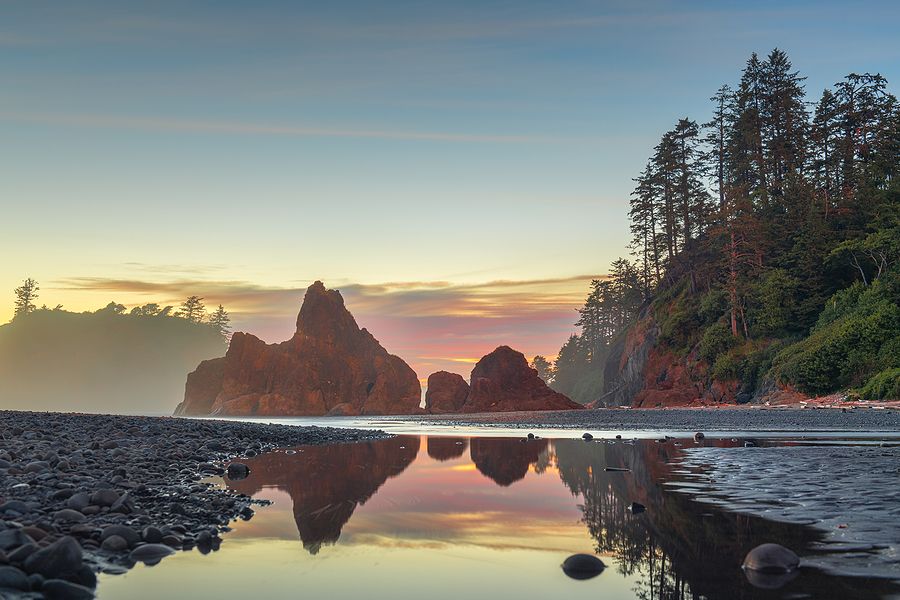
Best Time to Visit Olympic National Park with Kids
When planning your visit to Olympic National Park, timing can significantly enhance your experience. The period between June and October is often considered the best time to explore, as it features the most favorable weather conditions. Despite being the driest period, visitors should still be prepared for rainfall at any time. Visitors can enjoy hiking, camping, and beach activities during these summer months. However, June through September are particularly popular, offering the clearest days and the broadest range of activities.
Spring months—April and May—provide mild temperatures and less crowded trails, ideal for those seeking a quieter experience. The fall months of September and October offer stunning foliage and fewer visitors, making it perfect for tranquil sightseeing. Winter, from November through March, is an excellent time for wildlife enthusiasts, notably during the elk rut in October, and for snow sports like skiing and snowshoeing at Hurricane Ridge.
Choose your visit according to the activities you wish to pursue for a memorable adventure. Be prepared for any conditions. At Hurricane Ridge, snow can last well into the spring months. Rain and fog can inhibit visibility on roads and hiking trails. Always check current road and trail conditions before visiting.
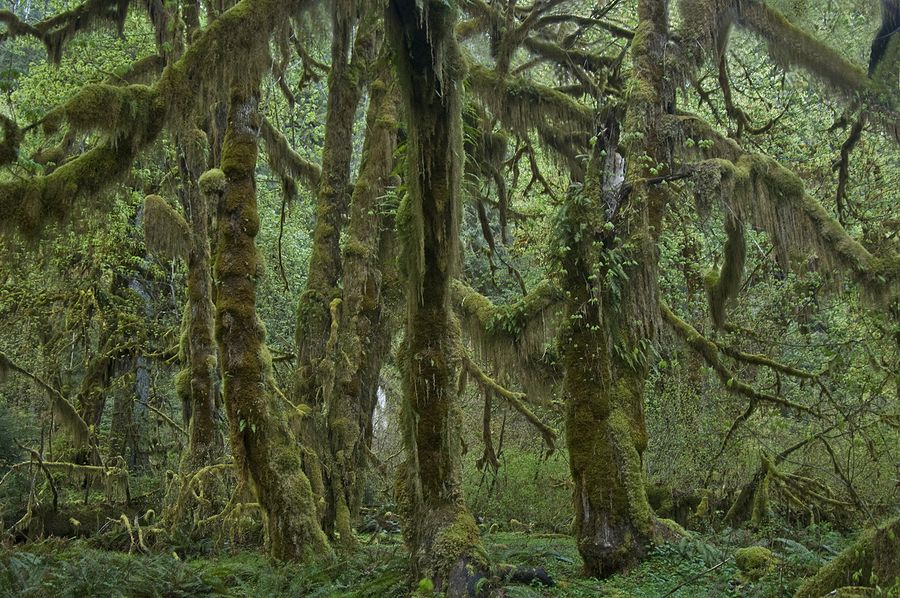
Plan Your Trip with Olympic National Park Visitor Centers and Information
Olympic National Park features several visitor and ranger stations. The main Olympic National Park Visitor Center near Port Angeles welcomes guests year-round—closed only on Thanksgiving and Christmas Day. Visitors can obtain wilderness camping permits and bear canisters at the adjacent Wilderness Information Center. Hurricane Ridge and Hoh Rain Forest also have staffed visitor centers offering maps, restrooms, and visitor programs. During summer, the Kalaloch Ranger Station off Highway 101 in Forks provides vital information about the coast and surrounding areas.

How to Get Around Olympic National Park
Navigating Olympic National Park requires some planning due to its size and diverse terrain. One of the most popular areas, Hurricane Ridge, can be accessed via the Clallam Transit shuttle service boarding in Port Angeles, which operates seasonally from late May through early September. This seasonal service is perfect for visitors who prefer not to drive and wish to avoid the congestion of peak tourist traffic. For those opting to drive their own vehicle, allow extra travel time due to the narrow, winding roads and potential traffic.
Before heading out through the park, check for any road closures or construction updates that might affect your travel plans. Information on current road conditions, including closures and construction alerts, is regularly updated on the National Park Service website. Use the helpful mileage chart above to help plan travel distances between points.
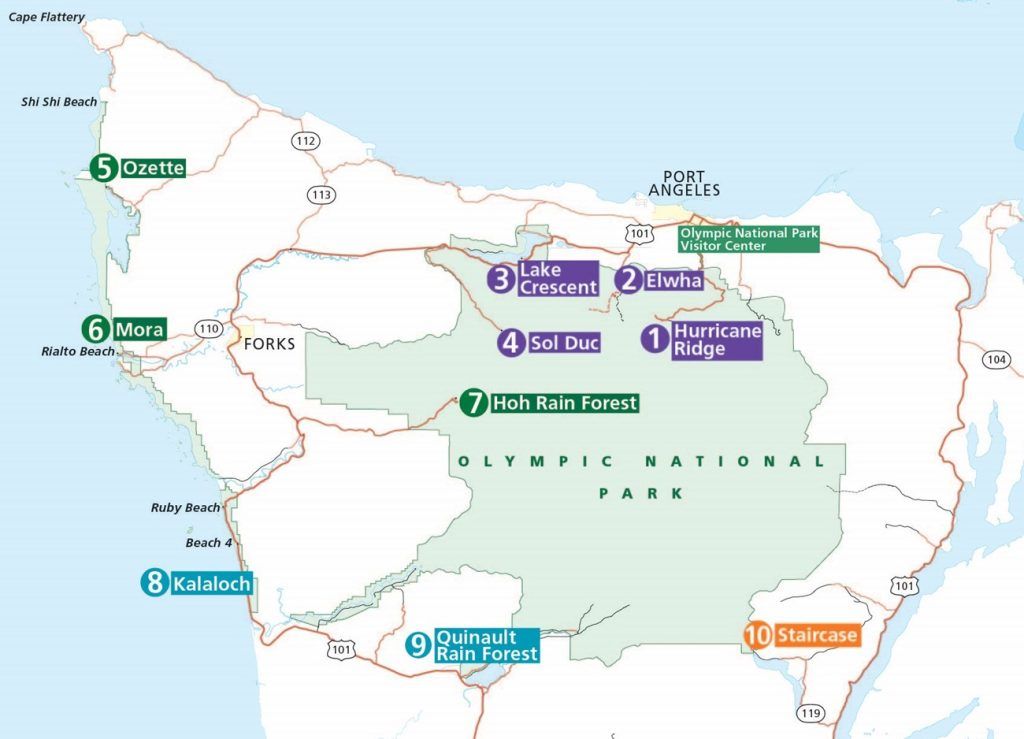
Explore the 10 Areas of Olympic National Park
With ten diverse areas, each offering a unique slice of nature’s wonders, Olympic National Park is a must-visit for families. From Hurricane Ridge’s majestic peaks to Lake Crescent’s calm waters and the Hoh Rain Forest’s lush ecosystem, every region is worthy of exploration. This guide will help you navigate each region. We’ll explore each area, uncover its distinct characteristics and natural beauty, and offer helpful tips for your visit.
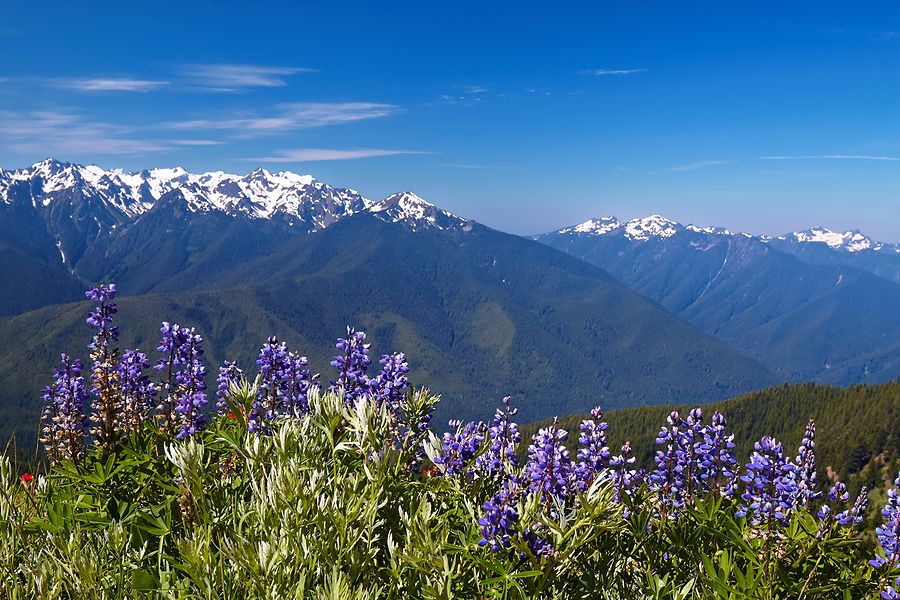
1. Hurricane Ridge
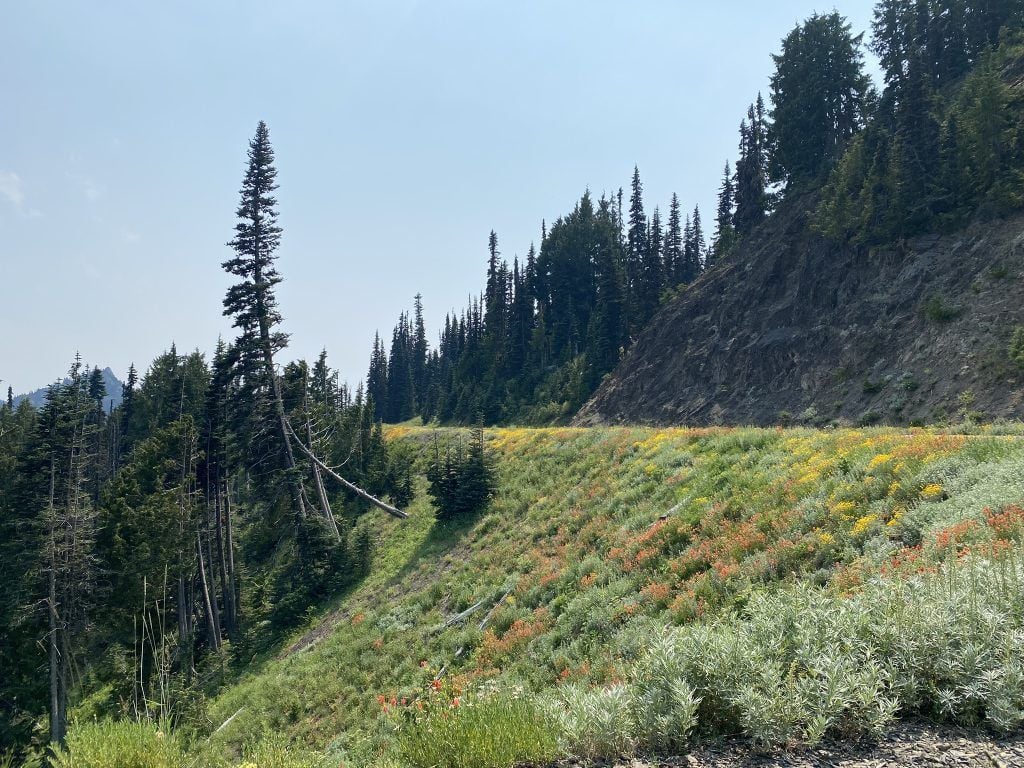
Before ascending to Hurricane Ridge, take a moment to explore the Heart O’ the Hills area, located along the route. This serene forested campground provides a beautiful setting with access to several hiking trails ideal for families. A popular hike is the 4-mile round trip Heart O’ the Forest Trail, offering a moderate hike through lush, verdant surroundings and diverse plant life.
The drive up to Hurricane Ridge in Olympic National Park is breathtaking. The 17-mile scenic road from the Olympic National Park visitor center winds through dense forests and steep mountain terrain, providing sweeping vistas of the surrounding landscape. As you ascend, the road narrows and twists, eventually opening up to reveal the awe-inspiring panorama at the top. You’ll enjoy views of several prominent mountain peaks, such as Mount Olympus, Mount Angeles, and the Bailey Range.
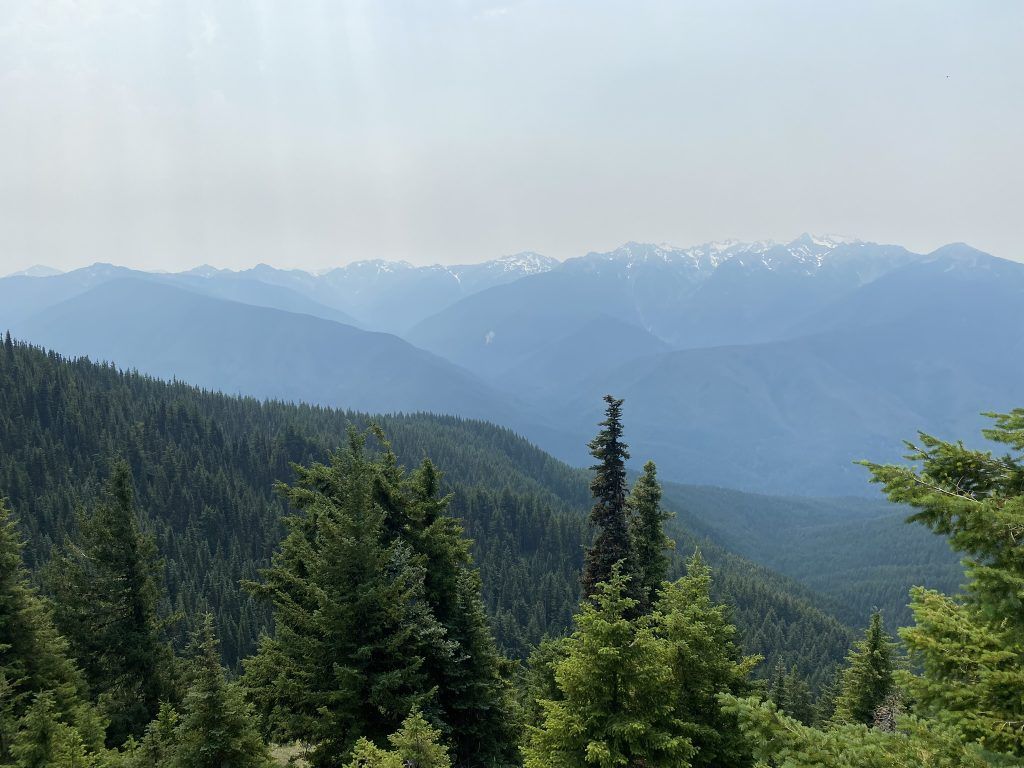
Schedule time to hike popular trails like the Hurricane Hill Trail, a moderate 3.2-mile round-trip hike, with even more panoramic views of the Olympic Mountains and the Strait of Juan de Fuca. Families can also opt for the more leisurely Cirque Rim and Big Meadow trails, which explore the area’s unique alpine ecosystem.
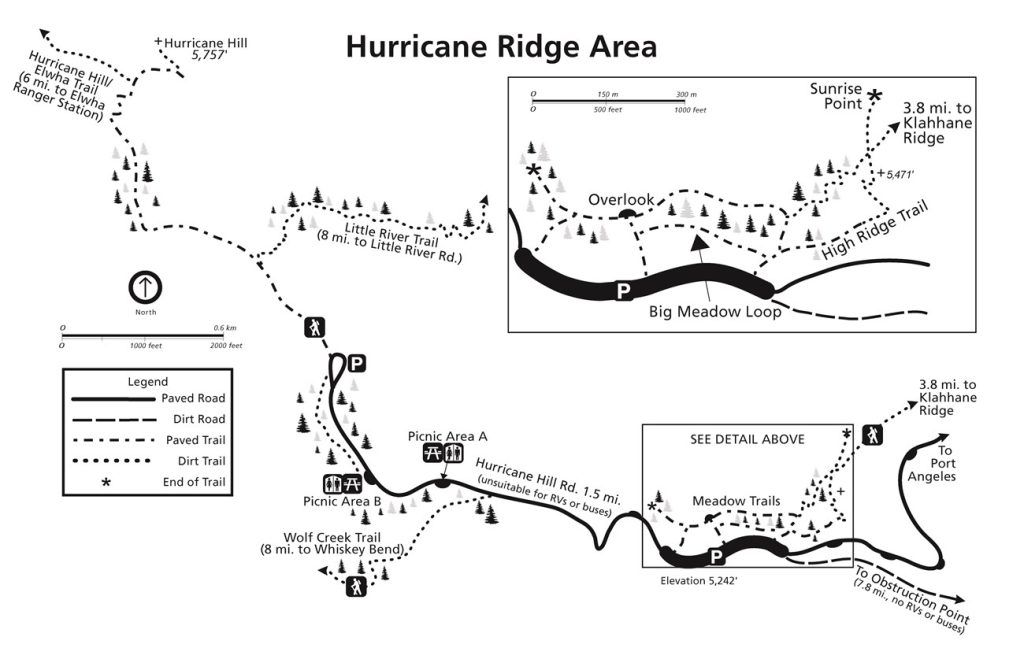
Visit tip: Check the National Park Service website for scheduled Telescope Program nights. Thanks to minimal light pollution, the Hurricane Ridge Astronomy Program, led by a Master observer, provides telescopic views of galaxies, nebulae, planets, and constellations, promising an evening filled with thousands of stars and discoveries.
2. Elwha Valley
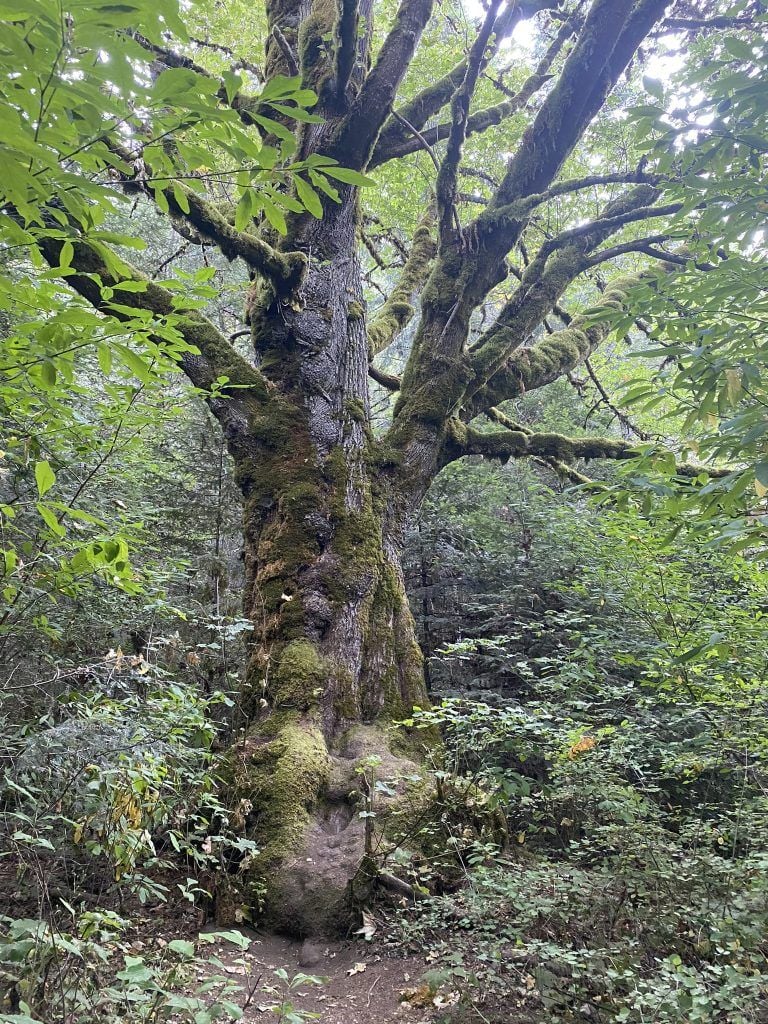
Located just 11 miles west of Port Angeles, the Elwha Valley is in ecological restoration and offers a glimpse of nature in recovery after the removal of two major dams. The Elwha and Glines Canyon Dams, built in 1913 and 1927, blocked fish migration in the Elwha River, harming local ecosystems. In 1992, Congress mandated the restoration of the watershed, leading to the removal of both dams by 2014. Following the removal, salmon began spawning in the park for the first time in a century, marking a significant ecological recovery.
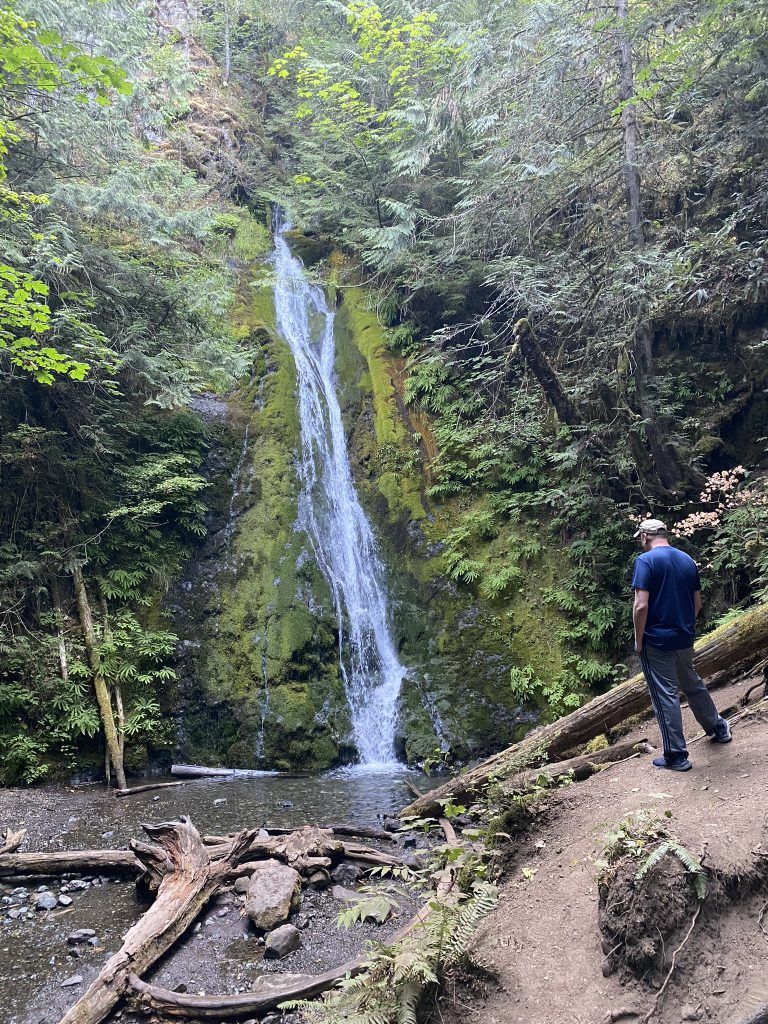
While some parts of the valley are currently accessible only on foot or by bicycle, the valley still offers a lot to see for visitors. A popular hiking option is the Boulder Creek Trail, which provides a journey through both lowland and montane forests. Despite some closures, don’t miss the easily accessible Madison Falls, an effortless 0.1-mile walk leading to a beautiful 60-foot cascade.
3. Lake Crescent
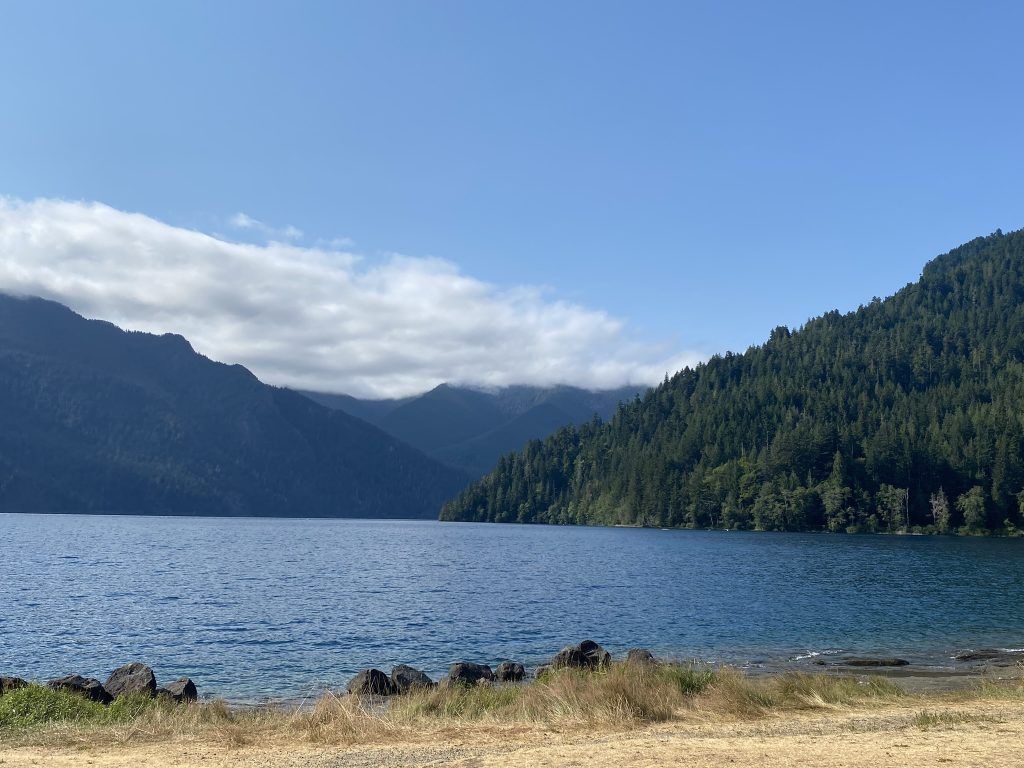
Lake Crescent has pristine waters in hues of sapphire and turquoise. The lake’s exceptional clarity, with visibility reaching up to 60 feet, results from its low nitrogen content, which inhibits algae growth. You can enjoy several beaches on the 12-mile-long lake. Fairholme Beach, located on the western end, is perfect for picnicking and swimming. For those seeking tranquility, La Poel Day Use Area offers a secluded spot, while East Beach has stunning views of Storm King Mountain and serves as an excellent kayak launch point.
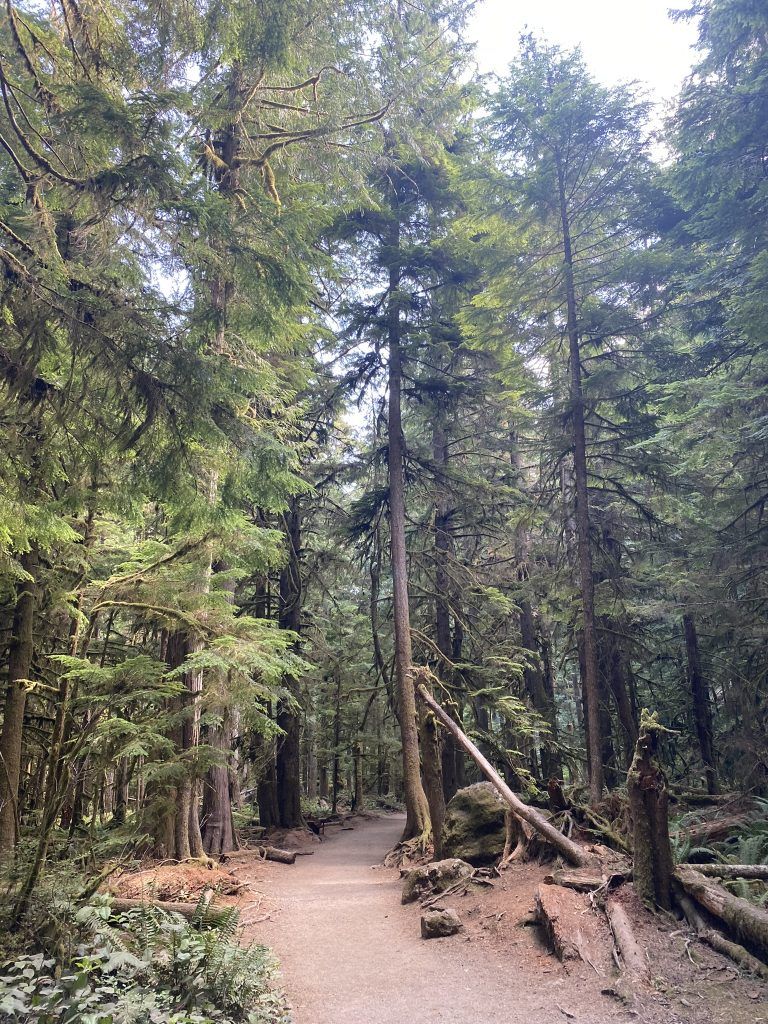
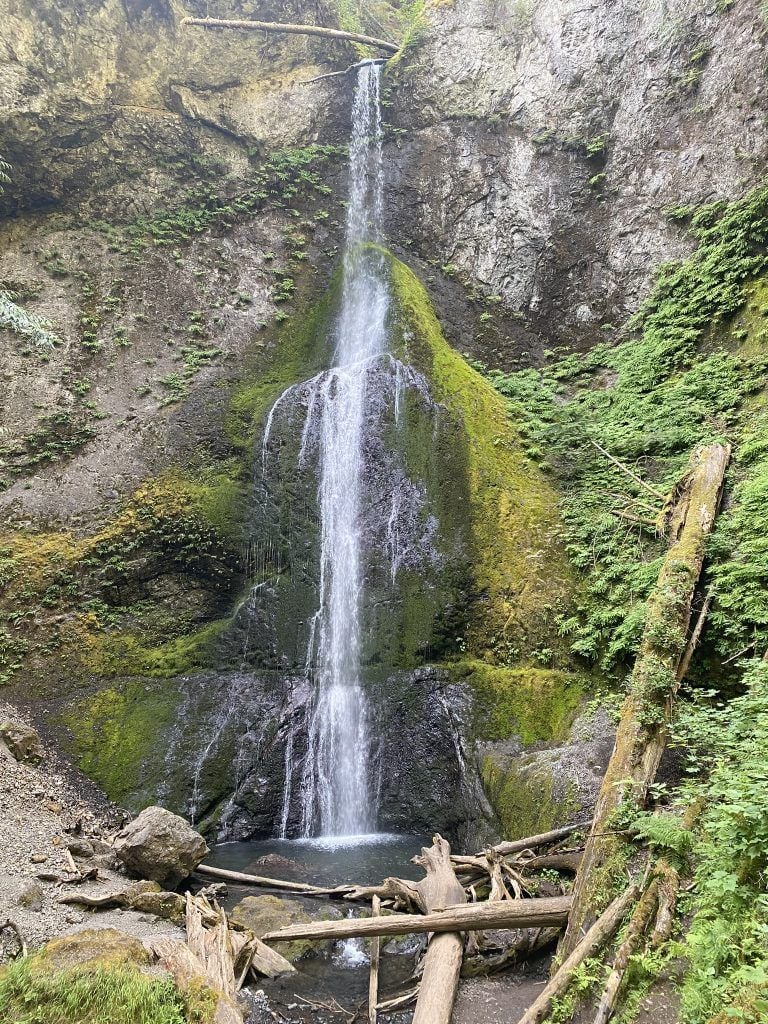
Driving along the southern shore has stunning views all around and plenty of great spots to pull over, take in the scenery, and snap some photos. Hiking trails around the lake include the Spruce Railroad Trail, an area highlight. This 8-mile round-trip trail follows a World War I-era railroad grade along the lake’s northern shore, featuring scenic viewpoints, the Devil’s Punchbowl swimming hole, and two restored railroad tunnels. For a shorter family-friendly hike, we enjoyed the Marymere Falls Trail, a 1.8-mile round-trip hike through an old-growth forest, leading to a stunning 90-foot waterfall.
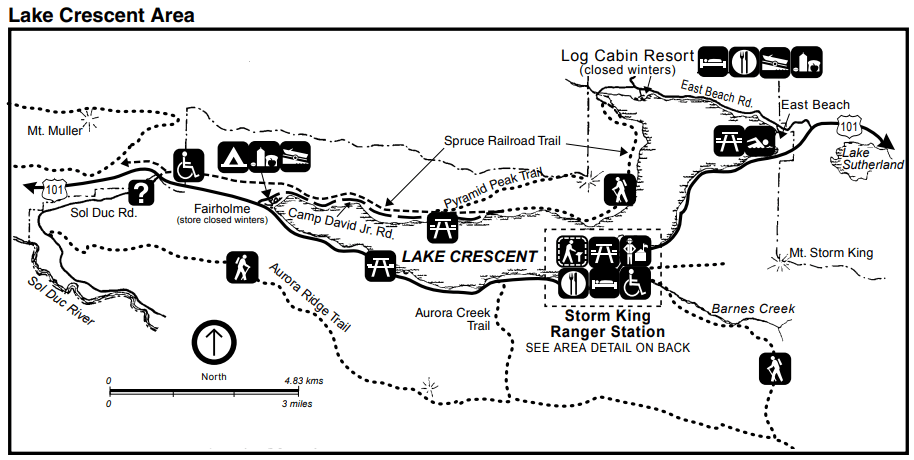
Visit tip: Consider renting a kayak or canoe from the Lake Crescent Log Cabin Resort for a delightful on-the-water experience, allowing you to explore the lake’s clear, vibrant waters at your own pace. Paddling across the lake offers unique views of the surrounding landscape and a chance to connect closely with nature.
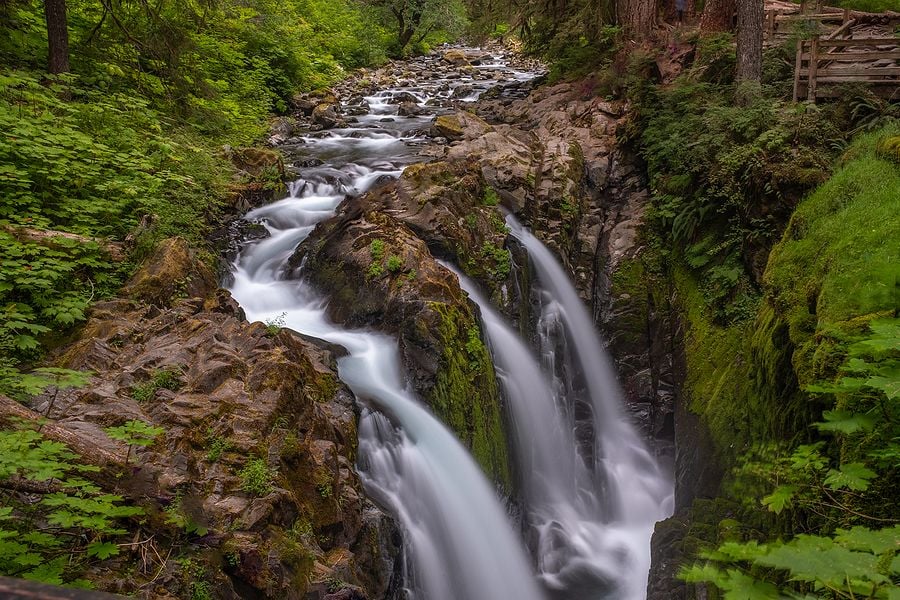
4. Sol Duc
The Sol Duc River winds through towering trees and hot springs, perfect for scenic walks and spotting wildlife. Families can unwind at Sol Duc Hot Springs Resort, soaking in mineral-rich pools surrounded by stunning forest views. Although the resort’s rooms don’t accommodate big families, you can buy access to the man-made pools. Time slots of 1.5-hour sessions can be purchased on a first-come, first-serve basis.
Sol Duc Falls is another popular attraction in the park. The falls drop approximately 48 feet, splitting into three or four channels cascading into a narrow gorge surrounded by lush, old-growth forest. The hike is an easy 1.6-mile round trip trek through the forest. However, finding parking can be challenging. When we visited, the parking lot was full and many people parked on the side of the road.
Once you reach Sol Duc Falls, continue 0.3 miles to Lovers Lane Falls. From here, you can backtrack to the trailhead or continue along Lovers Lane Trail along the river leading back to the resort. If you started at the resort because the Sol Duc Falls trailhead was packed, the loop is 6.0 miles round trip.
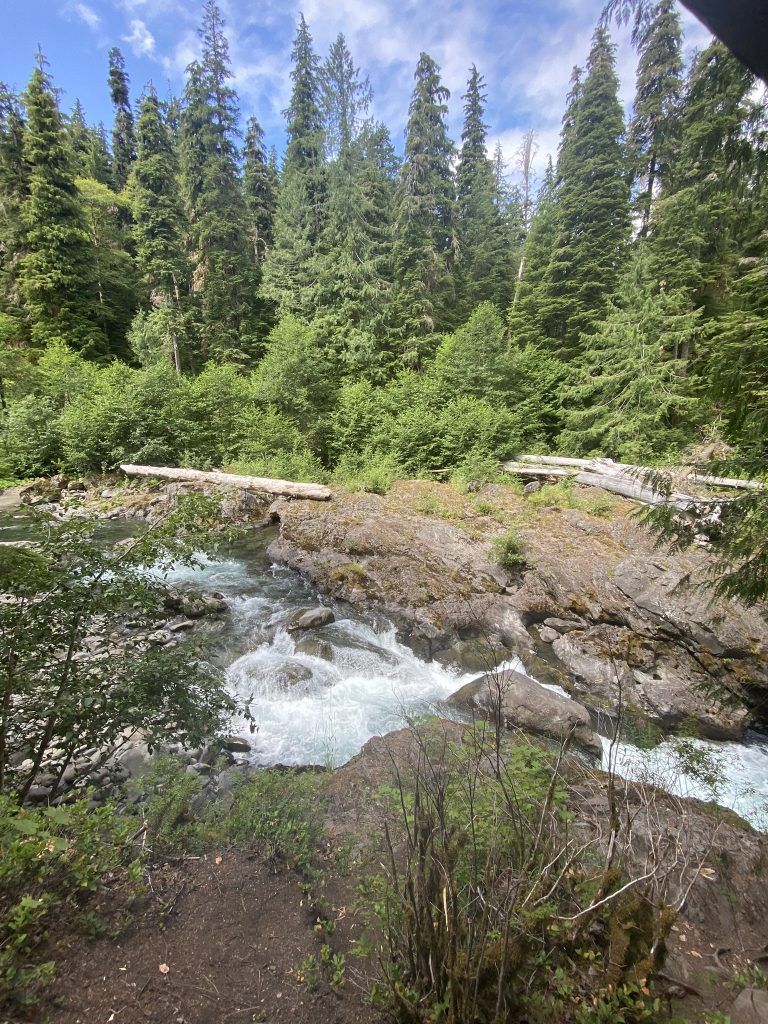
In addition to the iconic waterfall, the Sol Duc area features the Salmon Cascades, where visitors can witness salmon leaping upstream during the fall spawning season. Situated approximately 5 miles up Sol Duc Road, these cascades offer viewing platforms just a short distance from the parking area
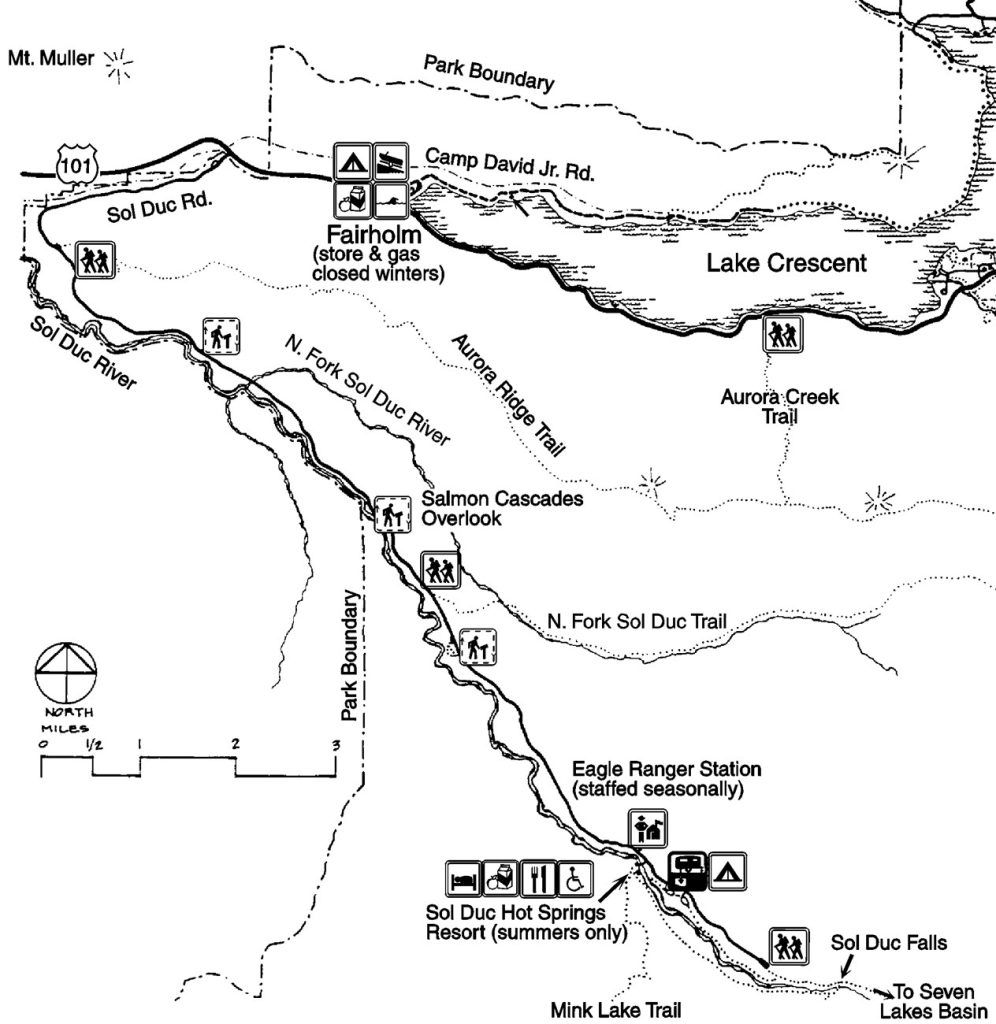
Good to know: Sol Duc Falls’ trailhead parking fills quickly, so opt for an early morning or evening visit to secure a spot. For a more extended adventure, consider starting your hike from the Sol Duc Hot Springs Resort if the main lot is full, making for a loop of about 6 miles round trip. Restrooms are also available at Campground B if you need a break before hitting the trail.
5. Ozette
Located on the northwestern coast of the Olympic Peninsula, enjoy hiking through the old-growth forests from Lake Ozette to the Pacific Coast. Two trails: Cape Alava and Sandpoint offer 3-mile walks to the coast along mostly boardwalk trails. At the coast, you can explore tide pools and, during migration seasons, catch a glimpse of seals and gray whales. The area has a picnic area, accessible restrooms, and primitive camping.

Good to know: You can hike the Cape Alva to the coast and Sandpoint trail back with the 3 miles of rugged coastline in between to complete the 9.2-mile Ozette Triangle. Know the tide times as some sections of the beach require scrambling over large logs during high tide. Schedule your hike to complete the first 3 miles and hit the beach section of your triangle during low tide. Don’t miss Wedding Rocks, which has 54 petroglyphs, about 1.0 to 1.25 miles south of Cape Alava. Boardwalks can be slippery when wet, have everyone wear appropriate footwear.
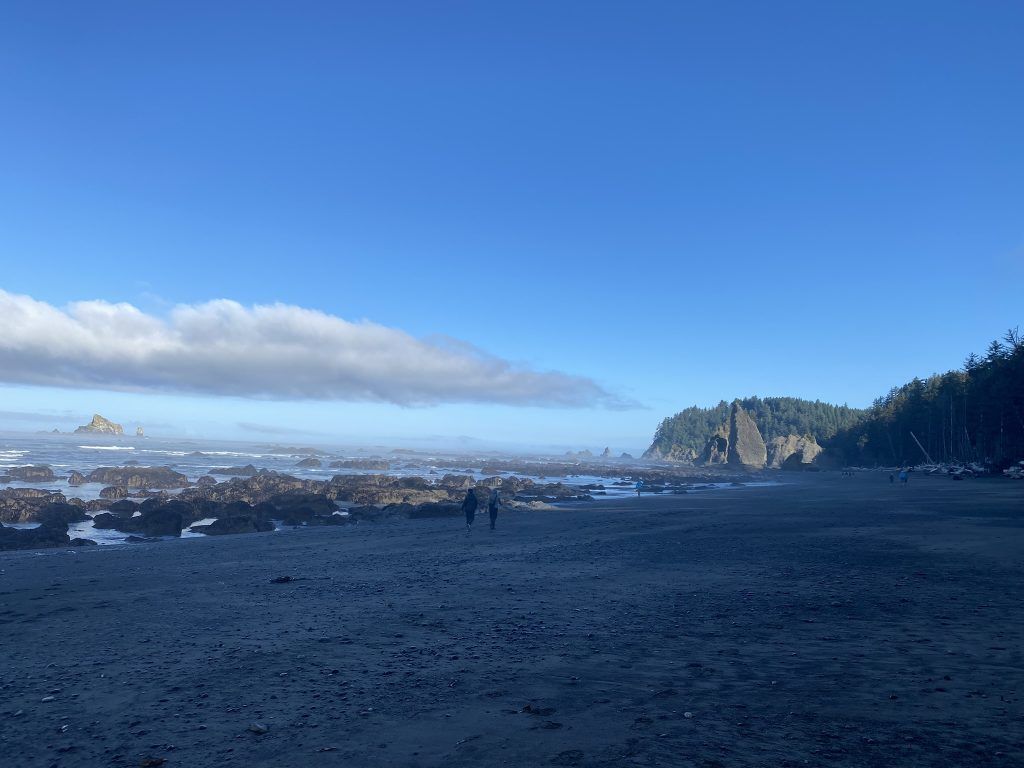
6. Mora
Mora offers visitors a scenic experience with its rugged beaches, towering drift logs, and dramatic sea stacks. The area’s natural beauty makes it a perfect spot for family adventures, from exploring fascinating tide pools brimming with marine life to enjoying the powerful views of crashing waves against the shore.
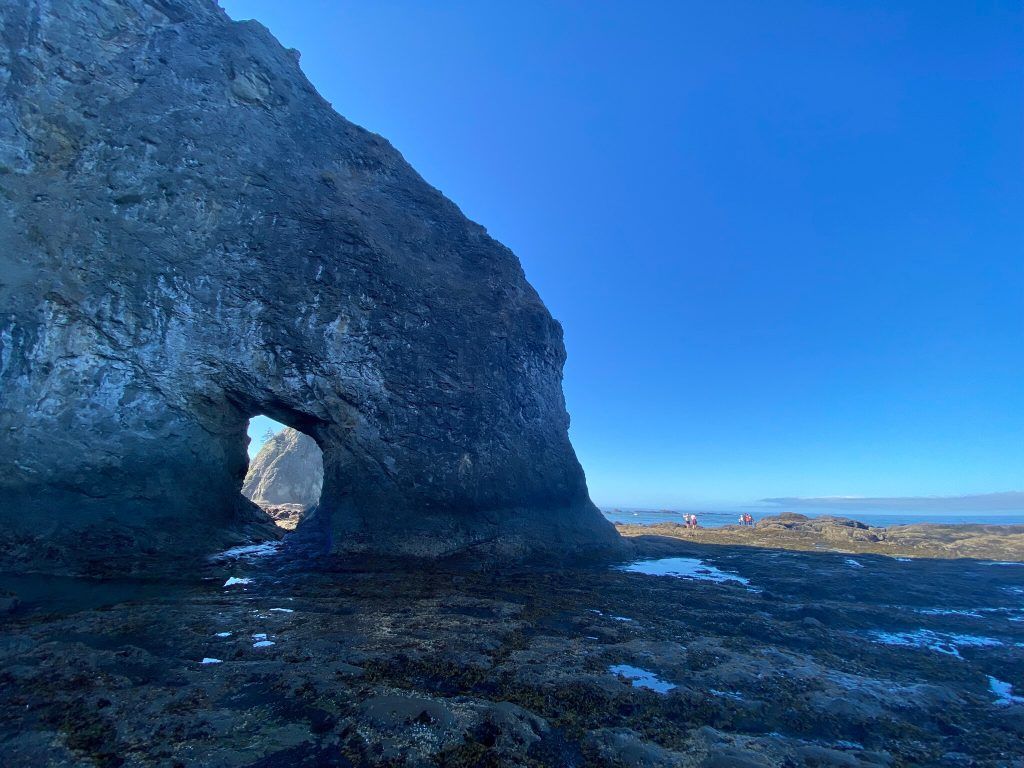
At Rialto Beach, walk the short 1.5-mile hike to Hole-in-the-Wall, a remarkable sea-carved arch. Along the beach, large drift logs, weathered and bleached by the sun and salt, lie scattered across the shore.
Try to time your visit during a negative low tide which reveals hidden tide pools and allowing safe passage through the arch. While the tide is out, the rocks surrounding Hole-in-the-Wall are uneven and often slippery. Some have a slick coating of kelp, adding an extra challenge to your footing. Take your time and watch your steps. Always be mindful of the tide schedule to give your family ample time to return before the water rises.

Visit tip: Wear footwear with traction and proceed slowly through the area. When walking on the beach to Hole-in-the-Wall, walk further up, away from the water. The sand is more compact and doesn’t give way as much as the sand near the surf, making for an easier walk.
7. Hoh Rain Forest
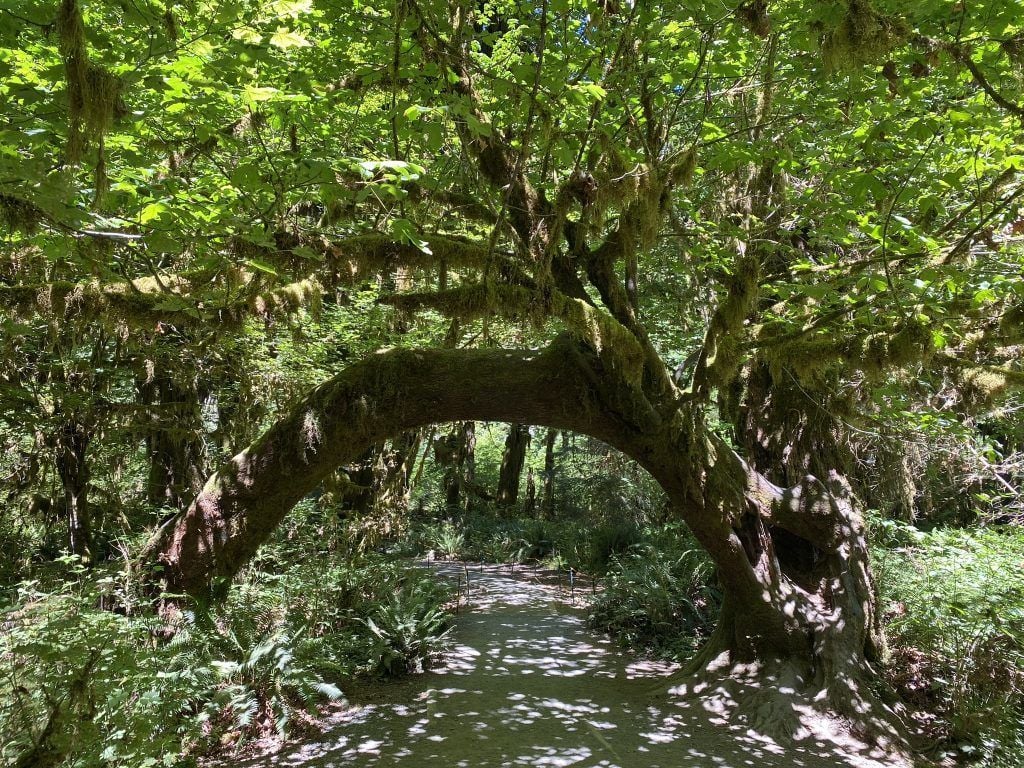
Located on the west side, the Hoh Rain Forest receives around 140 inches (3.55 meters) of precipitation annually. Two popular trails in the Hoh Rainforest are the Hall of Mosses Trail, a 0.8-mile loop through old-growth forest, and the 1.2-mile Spruce Nature Trail, which offers a walk through both old and new-growth forests.
As you explore the trails in the Hoh Rain Forest, you’ll find informative placards that provide an educational overview of the area’s unique ecology. These signs highlight fascinating features like the area’s nurse logs – fallen trees that foster new life by supporting the growth of seedlings on their decaying bark. You’ll also learn about clubmoss, ancient plants that thrive on air and light, showcasing their resilience in the rainforest’s lush environment. Additionally, the placards discuss the purity of Taft Creek’s spring water, which nourishes this lush landscape.
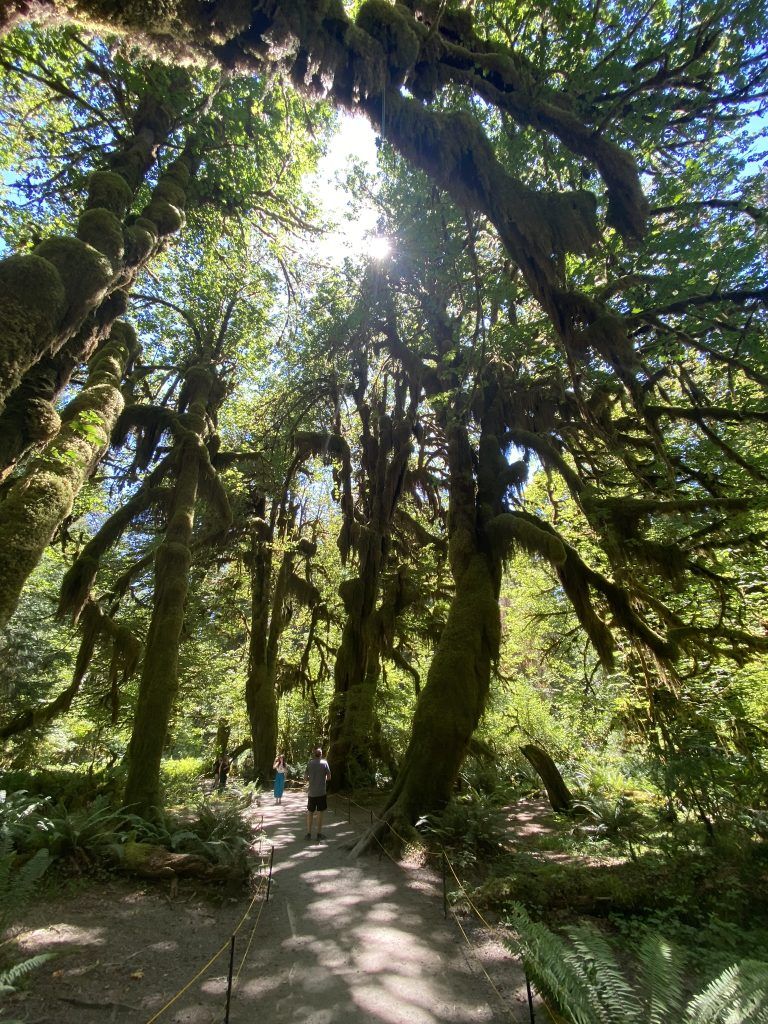
In the Hoh Rainforest, some trees are hundreds of years old and can reach towering heights of over 200 feet. The lush environment supports a variety of mosses that blanket tree trunks and branches, adding to the forest’s rich, layered appearance. During our visit in late July, we could tell it hadn’t rained for some time. The ferns along the trails were dusty from hiker traffic. More vibrant greens and lush moss can be seen during wetter periods. The visitor center has flush toilets and a few educational exhibits.
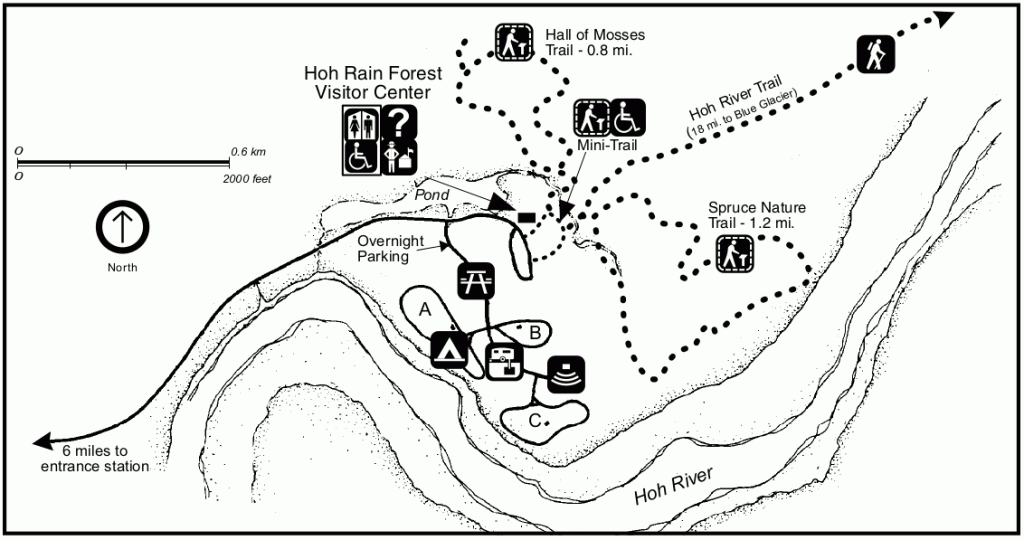
Good to know: This area is very popular with visitors, and wait times to drive past the entrance ranger stand can be up to 3 hours. We recommend visiting either very early or after 5 pm. However, we visited during a July weekday at noon and waited only 45 minutes. When we left at 3 pm, the line to enter was 3 cars long. We recommend visiting on a weekday.
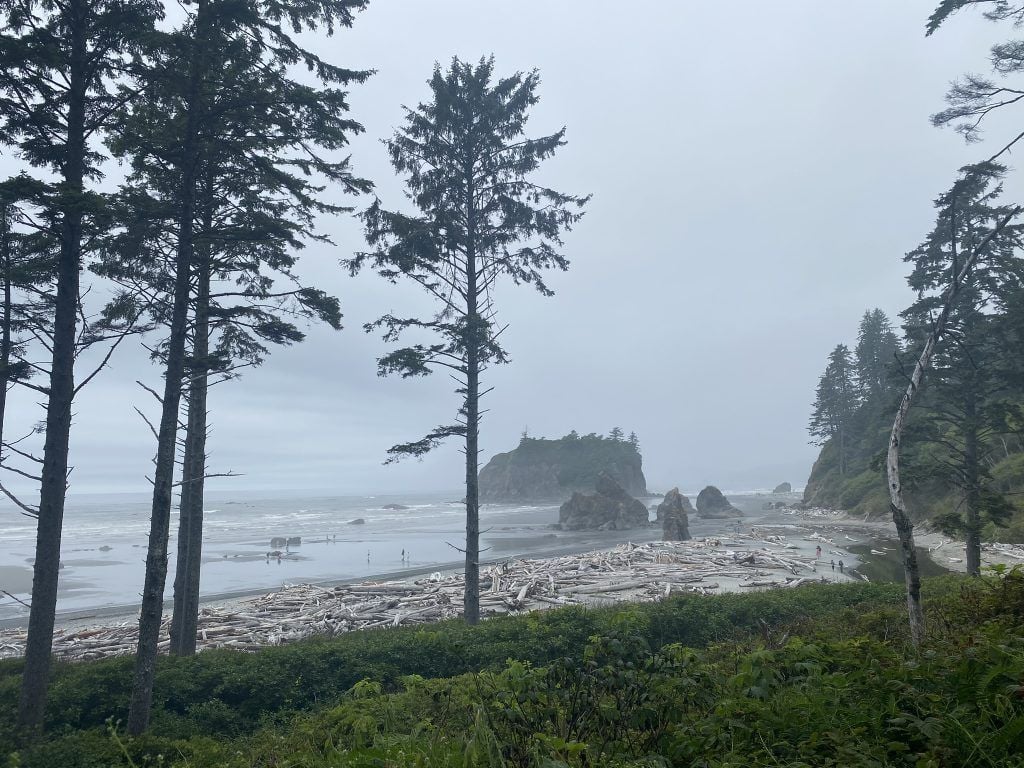
8. Kalaloch
Located on the southwest coast of the Olympic Peninsula, Kalaloch offers beach family fun with stunning coastal scenery. Plan a day of tidepooling at Ruby Beach or Beach 4. Ruby Beach has a large parking lot with vault toilets, along with a gentle gravel path descending to the extensive beach.
As you travel along US Highway 101 between Ruby Beach and Fourth Beach, keep an eye out for the sign marking the stop to view the Big Cedar Tree (about milepost 170). This massive ancient tree, at 175+ feet tall and nearly 20 feet in diameter) is a natural marvel, towering above with its intricate network of twisting roots and sprawling branches.

Beach 4 was the best of the three tide-pooling beaches we visited. Accessing the beach involves descending steps down a 1.1-mile trail, followed by crossing a driftwood bridge, and scrambling down a rock formation with a rope to assist. The beach is a small, rocky cove surrounded by towering cliffs and massive boulders, creating a unique and dramatic landscape.
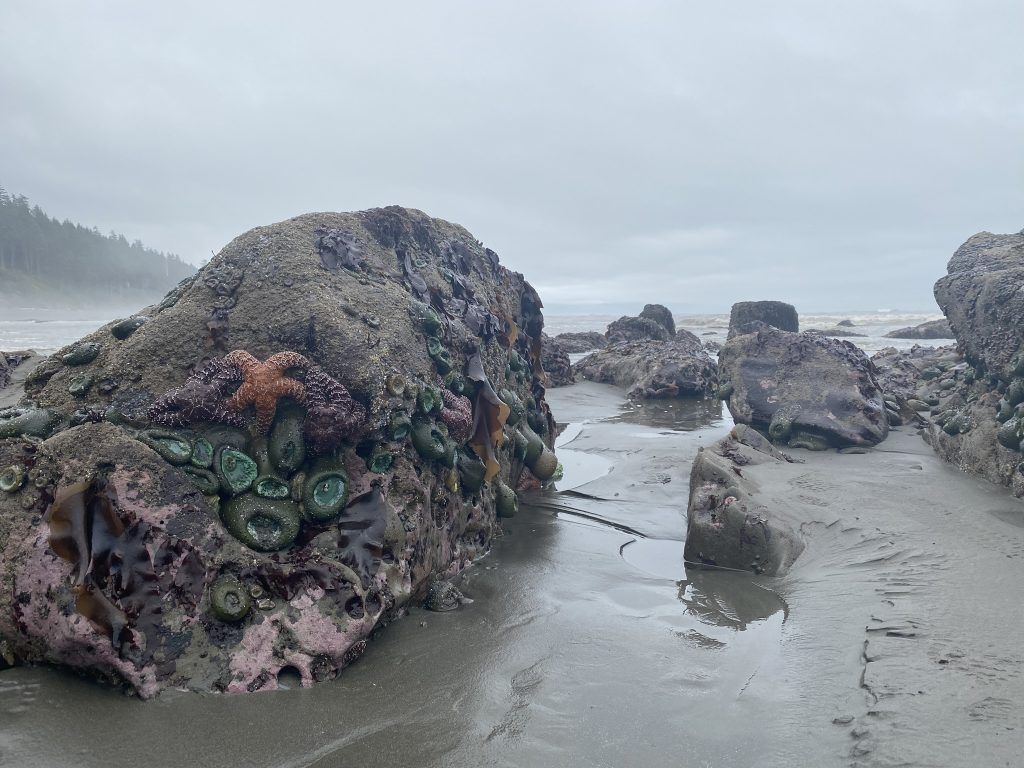
As you explore the tidepools at Beach 4, be sure to look for the colorful sea anemones, mussels, sea stars, and barnacles that call this area home, as well as the occasional octopus making an appearance in the shallow pools.
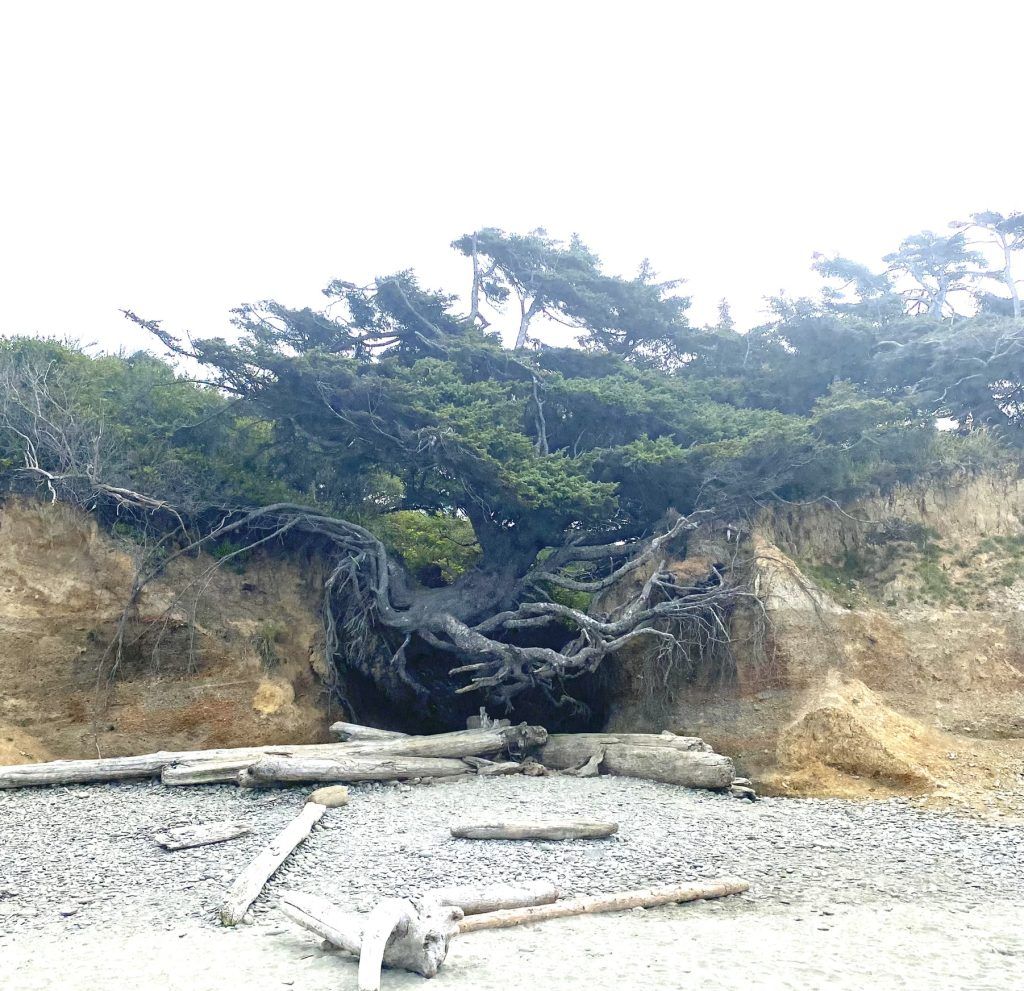
While visiting Kalaloch, be sure to check out the iconic Tree of Life located near Kalaloch Campground. To find this unique natural wonder, park in the day-use area and follow the short easy path and stairs down to the beach. A short walk to the right leads to the tree, which clings precariously between two cliffs.
Visit tip: To enhance your time tide pooling, before your trip or at the ranger station buy a laminated guide to tide pool marine life to identify what you see. During our visit, a park ranger was onsite at Beach 4 and gave out laminated identification field guides to help learn about cnidaria, arthropods, mollusks, and echinoderms.
9. Quinault Rain Forest
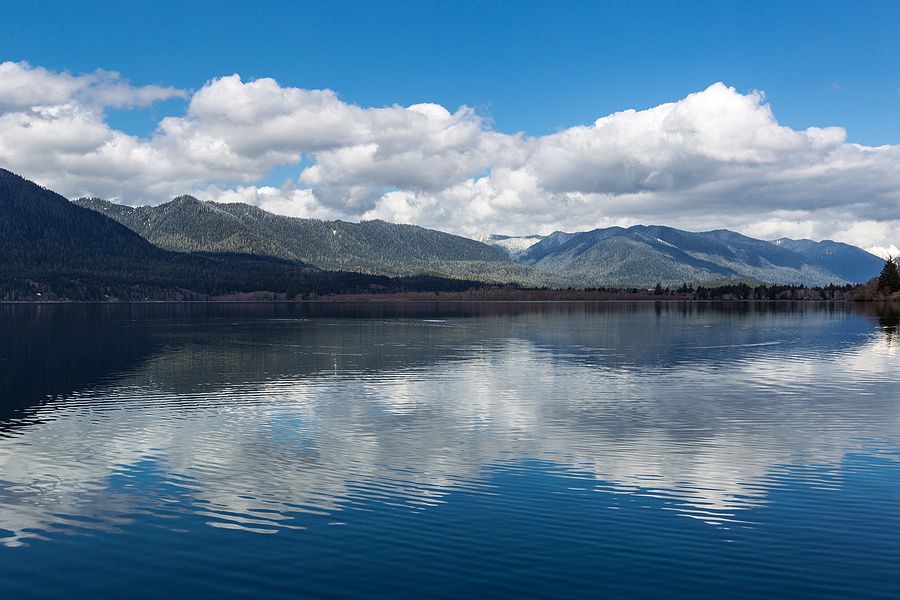
The Quinault Rain Forest receives 10 to 15 feet of rainfall each year. So it’s no surprise you’ll find the World’s Largest Sitka Spruce, standing nearly 200 feet tall with a massive 58-foot circumference. Nearby, Quinault Lake stretches for 14 miles, reaching depths of over 240 feet. Encircling the lake, North and South Shore Roads lead to waterfalls, rainforest, and history.
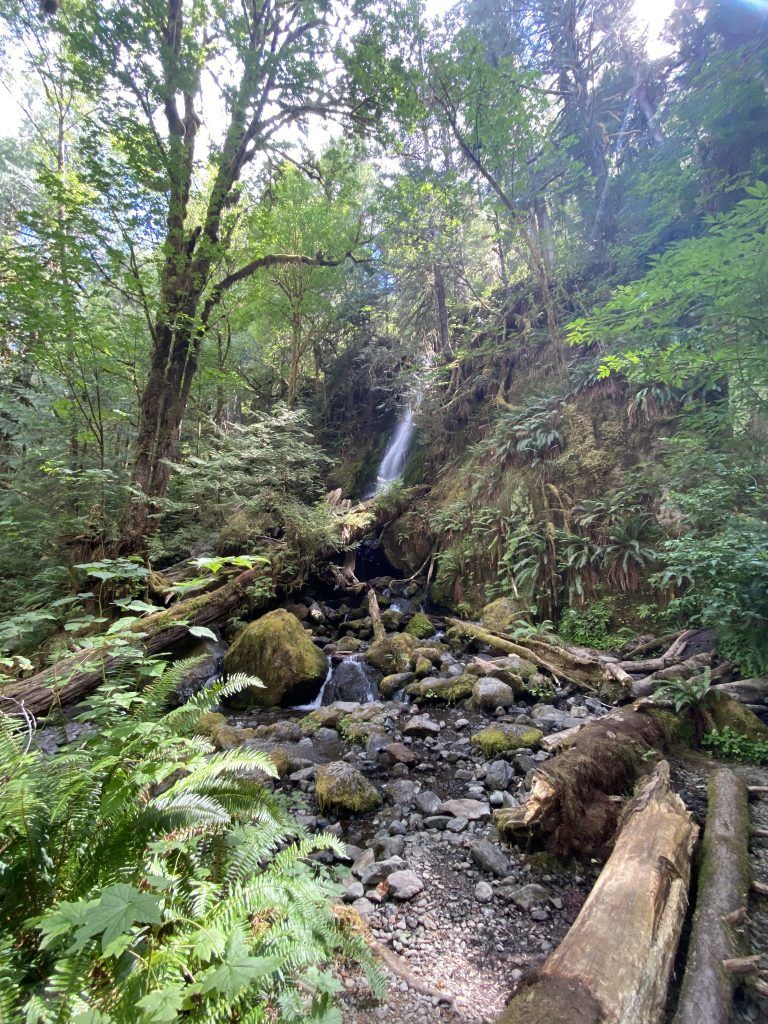
Along South Side Road, schedule time to hike to one of the area’s falls. Gatton Creek, 0.6 miles, and Cascade Falls are great hikes while Merriman Falls is located roadside. Look for the Merriman Creek sign and park along the road after the bridge. Explore Lake Quinault with a canoe, kayak, or paddleboard rental from Lake Quinault Lodge. Check out the Lake Quinault Museum in the Old Quinault Post Office. Learn about the history of the area. While admission is free, donations are welcome.
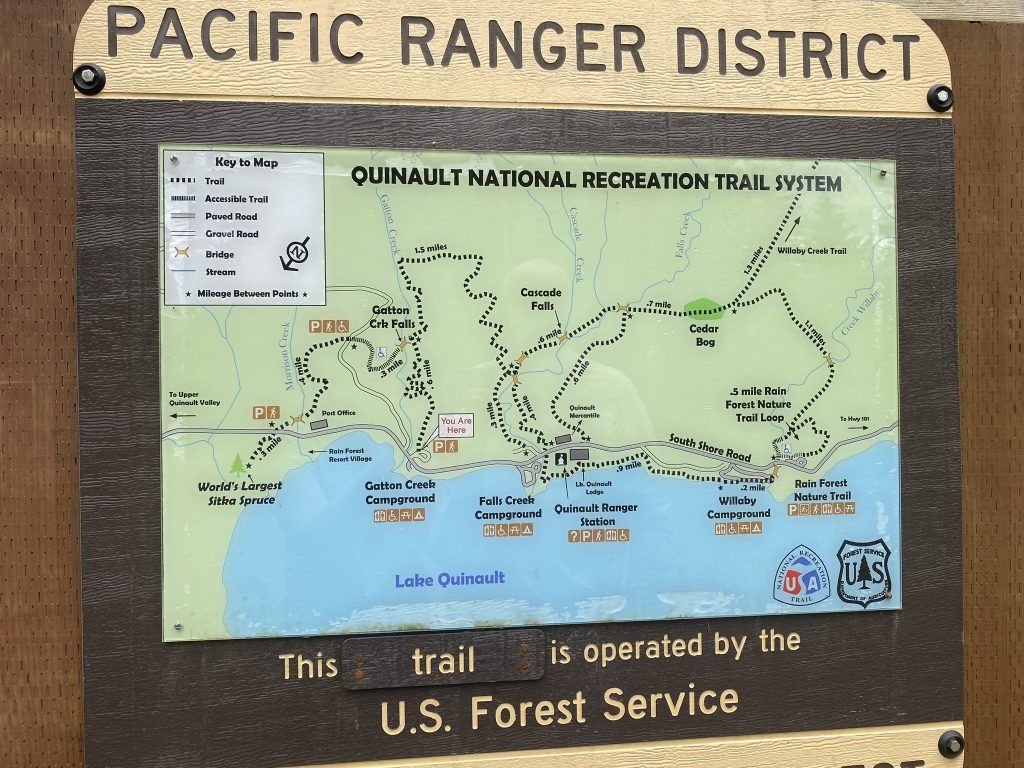
Along North Side Road, Maple Glade Loop provides a gentle half-mile walk. For a bit of history, complete the 1.3-mile loop hike to Kestner Homestead. Pick up a brochure with descriptions of Maple Glade and Kestner Homestead Trails. This historical site offers a fascinating glimpse into the lives of early settlers. Part of the road, approximately 8 miles, lies within the Quinault Indian Reservation.
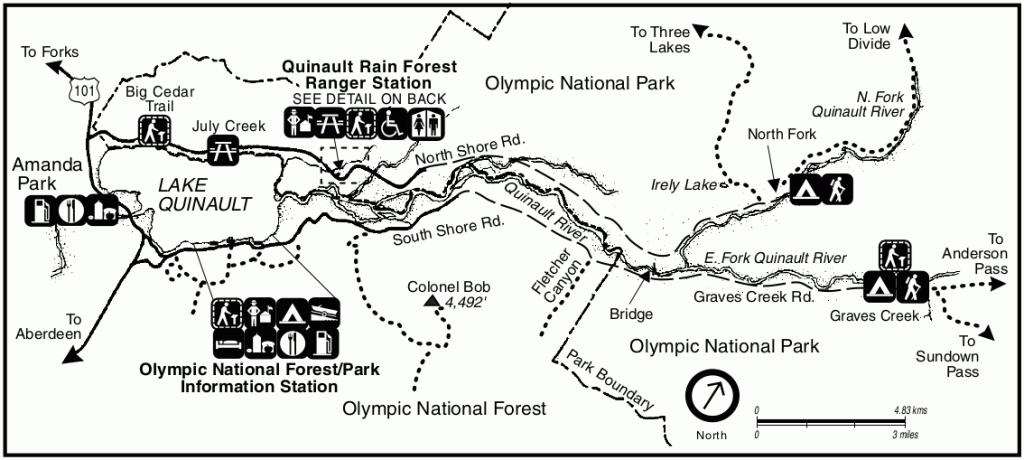
Visit tips: The dirt road to the parking lot 0.3 miles from Gatton Creek Falls looks like a great way to shorten your hike instead of starting near the Gatton Creek Campground. However, the “road” is a severely overgrown, rutty, single-lane path to a small parking area. Our Jeep Cherokee had no problem traversing the road and luckily we encountered no vehicles coming from the opposite direction.
Complete the 31-mile Quinault Loop Drive around Lake Quinault. South Shore Road and North Shore Road, located on Quinault Indian Reservation, are connected by 17 miles of gravel road. North Shore Road and South Shore Road. Check the NPS site for road closures. Note that the road is not open to RVs or trucks hauling campers.
10. Staircase
Getting to Staircase is easy – just drive west from Hoodsport for 16 miles along N Lake Cushman Road/Hwy 119. The Staircase area is a stunning display of old-growth forests filled with towering Douglas-firs. This unique ecosystem, shaped by natural forest fires every few centuries, offers a rich environment where these impressive trees flourish in open soil. Families looking for adventure will love the Staircase Rapids Loop. This easy 2-mile path winds through lush greenery, offering amazing views of the North Fork Skokomish River.
Don’t miss the Big Cedar Tree, a quick side trip off the main trail that’s well worth your time. The path then leads to a cable bridge, hanging excitingly over the Skokomish River, adding a fun twist to your hike as you cross above the rushing water. For those wanting to explore more, the nearby Shady Lane Trail to Four Stream and Lake Cushman offers a flat 0.9-mile walk in peaceful surroundings. After your hike, on the way out of the area, be sure to stop at the Bear Gulch Picnic Site for a break.
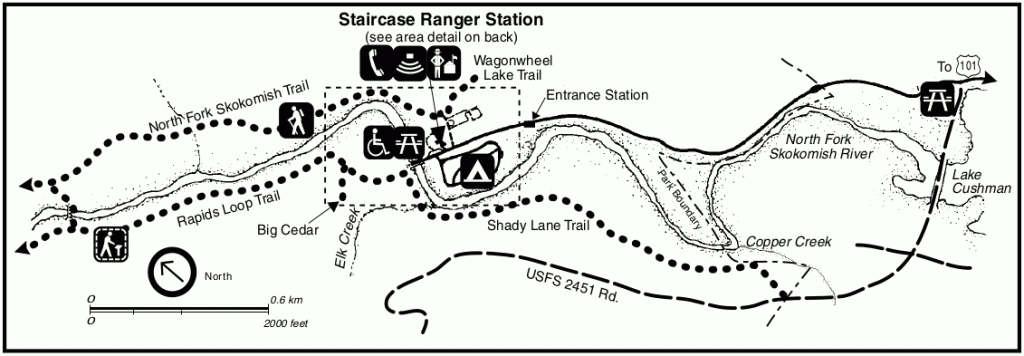
Good to know: When planning an afternoon at Lake Cushman Reservoir, be aware that it is very popular on weekends due to its excellent swimming, fishing, and boating opportunities.
Hiking in the Olympic National Park
Olympic National Park offers over 600+ miles of trails, giving hikers of all levels plenty to explore. From newbies to pros, there’s a path for everyone. Many trails allow you to explore rugged peaks, lush forests, and peaceful beaches. It’s a great way to soak in nature’s wonders. Check out our handy guide to easy family-friendly hikes. These family-friendly trails are perfect for your whole crew. They fit easily into busy schedules and let you enjoy the park’s beauty at a relaxed pace. They’re a great way to explore each area and see the park’s beauty.
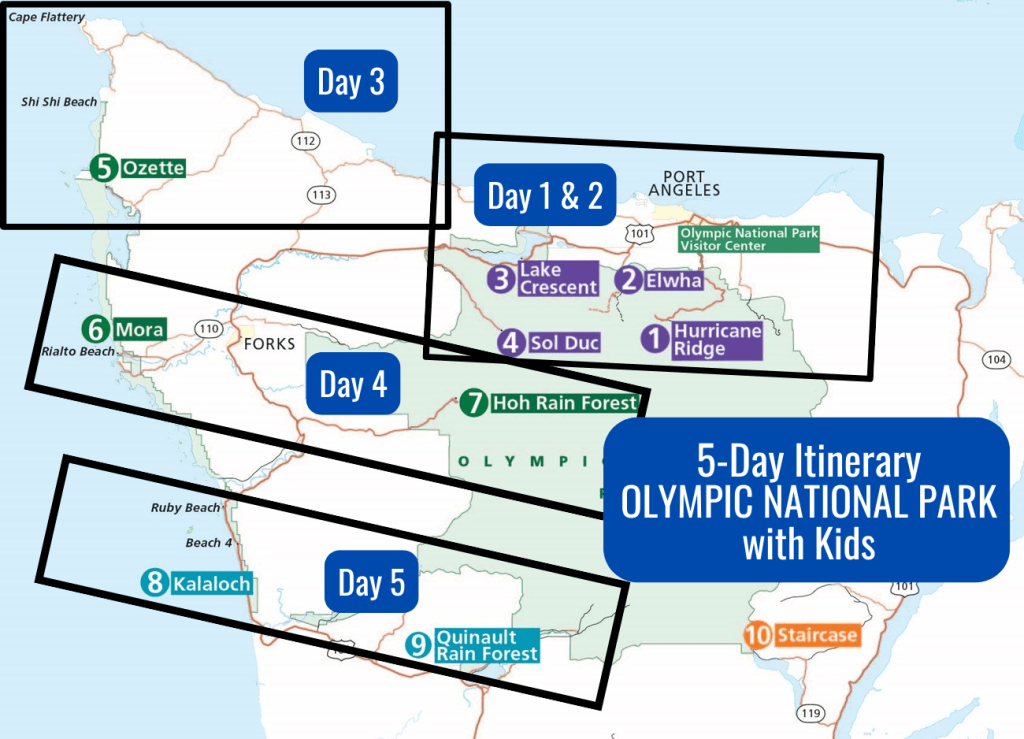
5-Day Olympic National Park Itinerary with Kids
How to Plan a Trip to Olympic National Park
This 5-day plan helps you and your kids see the best of Olympic National Park. Each day is full of fun activities and amazing views. The plan includes short, easy walks that let you see a lot on a limited vacation schedule. Plus, this itinerary covers 9 out of 10 park areas, with the 10th area, Staircase, easy to visit on your way to Port Angeles or as part of the Olympic Peninsula Loop.
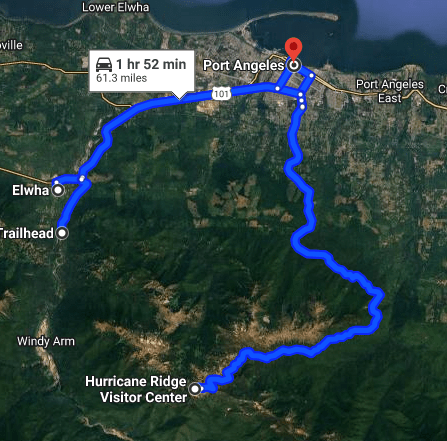
Day 1: Hurricane Ridge and Elwha
Start your day with a visit to Hurricane Ridge, one of the most accessible mountain areas in the park. Take in the stunning views of the Olympic Mountains and the Strait of Juan de Fuca. For a more in-depth experience, hike the Hurricane Hill Trail, a moderate 3.2-mile round-trip hike that offers breathtaking views of the surrounding landscape.
After exploring Hurricane Ridge, head to the Elwha Valley, where you can take a short walk to Madison Falls, a beautiful 60-foot cascade. Pack a lunch to enjoy in the valley or at one of the many scenic viewpoints along the way.
At the end of the day, head back to Port Angeles, where you’ll be staying for the next two nights. Take some time to explore town, visit the Port Angeles Harbor, and enjoy dinner at one of the local restaurants. The next day will bring more adventures in the park, so be sure to rest up!
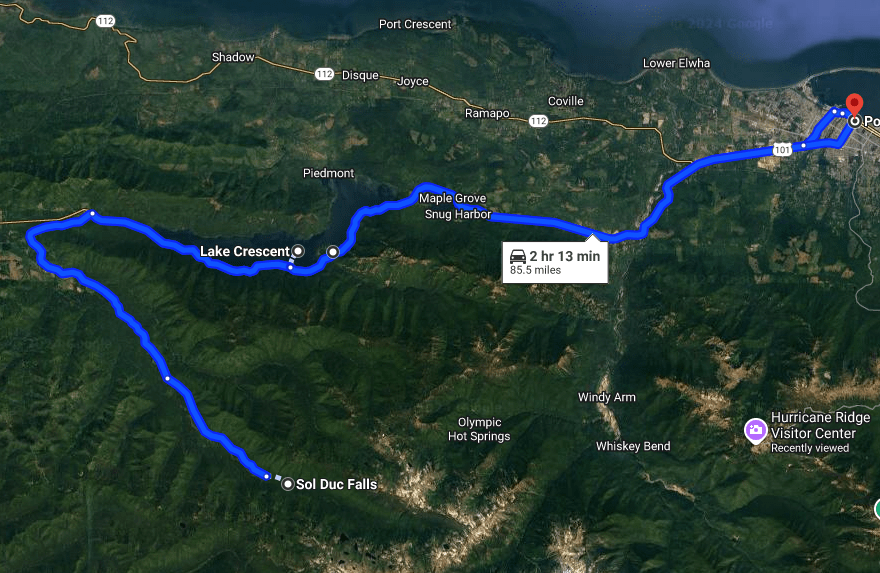
Day 2: Sol Duc and Lake Crescent
Today, start your day early to visit the Sol Duc area, where you can soak in the natural hot springs and explore the surrounding forest. Take a short hike to Sol Duc Falls, a 1.6-mile round-trip trek through the forest, and if you’re feeling adventurous, continue on to Lovers Lane Falls.
After exploring Sol Duc, head to Lake Crescent, where you can enjoy a picnic lunch and take in the stunning views of the lake. Consider renting a kayak or canoe from the Lake Crescent Log Cabin Resort to explore the lake’s clear, vibrant waters. If you have time, hike the Marymere Falls Trail, a 1.8-mile round-trip hike through an old-growth forest that leads to a stunning 90-foot waterfall.
At the end of the day, head back to Port Angeles, to spend your second night. If you have time, add in a visit to Feiro Marine Life Center or Dungarees National Wildlife Refuge.
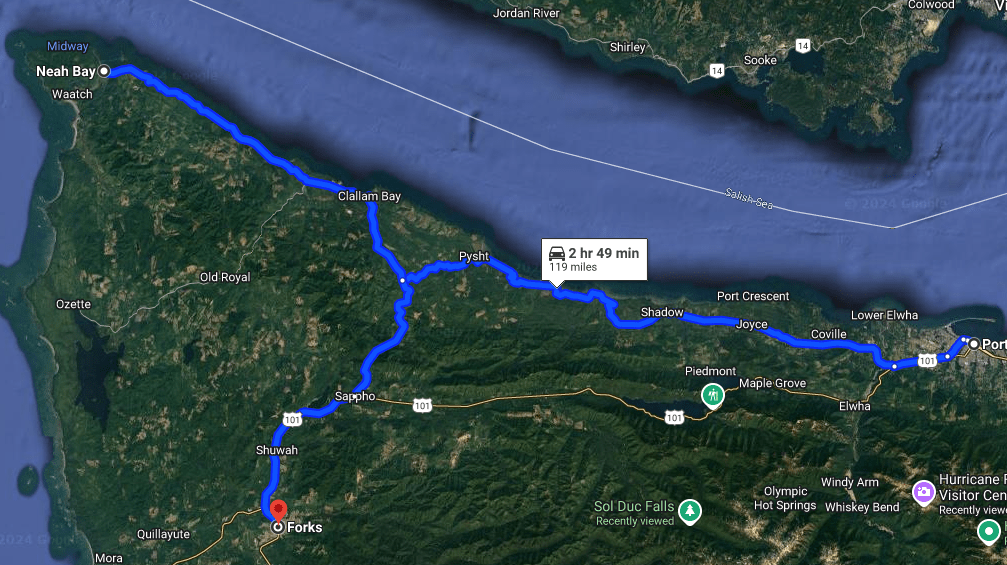
Day 3: Option 1 – Strait of Juan de Fuca Scenic Byway to Neah Bay
Today, take a scenic drive along the Strait of Juan de Fuca Scenic Byway (Highway 112), which offers stunning views of the strait and the surrounding landscape. Stop at the Salt Creek Recreation Area, Pillar Point County Park, and Clallam Bay Spit County Park for some beachcombing and exploration.
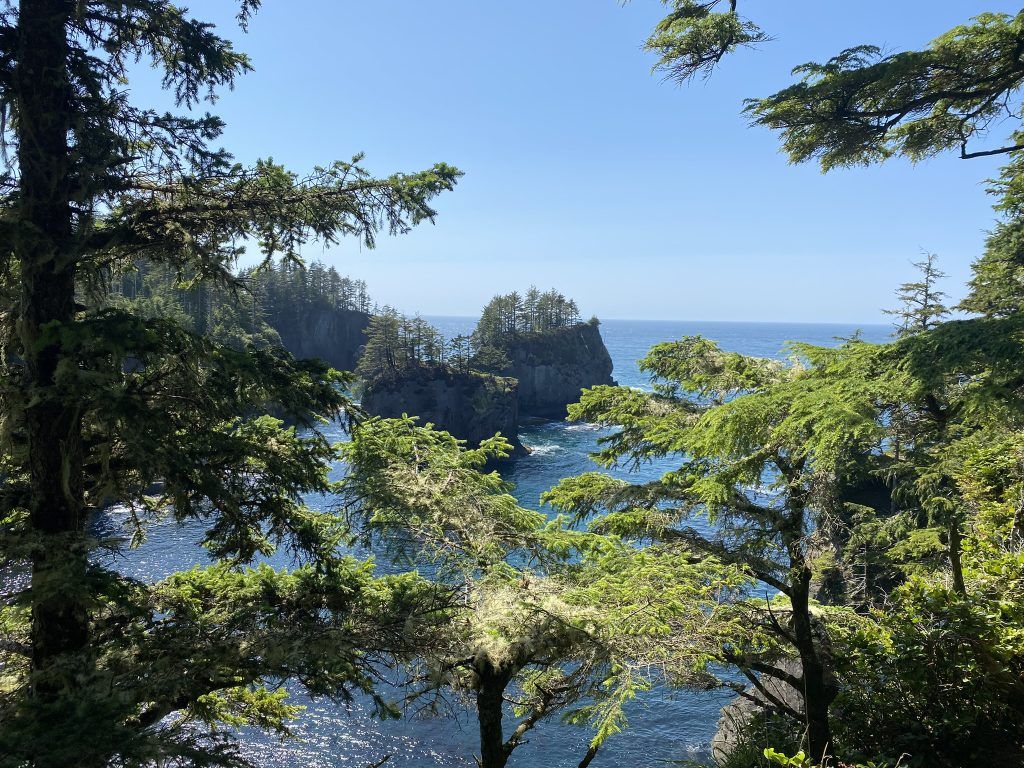
The highlight of the day is a visit to Cape Flattery, located on the Makah Indian Reservation in Neah Bay. This point is not only breathtakingly beautiful, but it’s also the furthest northwest point of the continental United States. The Makah Tribe has lived in this area for thousands of years, and their cultural heritage is still thriving today. Stop at the Makah Cultural and Research Center to learn more about the tribe’s history and traditions.
To access Cape Flattery, you’ll need to pay a $20 entry fee, which supports the Makah Tribe’s conservation efforts. From the parking area, take a short hike along boardwalk trails to the viewpoint, where you can see the stunning cliffs, islands, and ocean views.
After exploring Cape Flattery, head to the charming town of Neah Bay, where you can grab lunch and browse the local shops and galleries. Book your next hotel for two nights in the nearby town of Forks. To replenish your food supplies, visit Thriftway Washington Food Store.
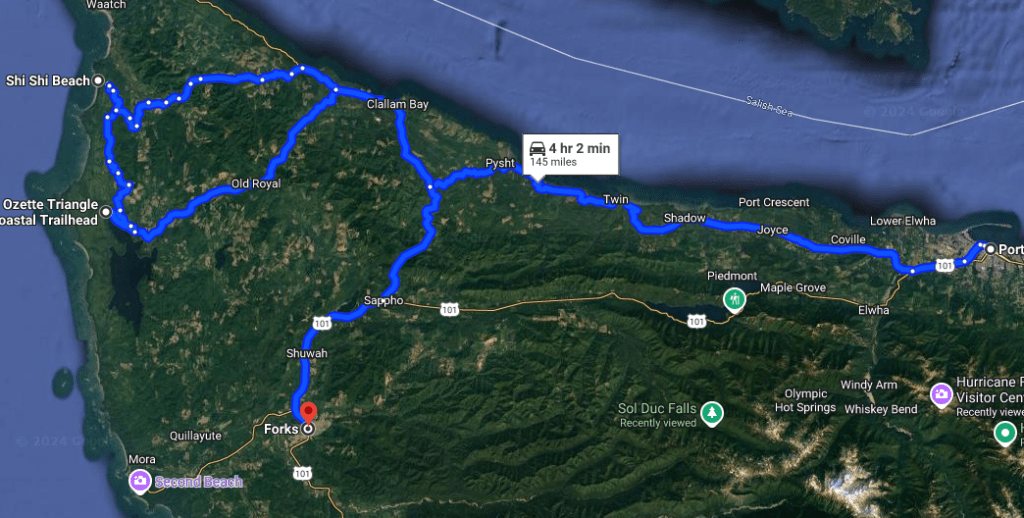
Day 3: Option 2 – Ozette and Shi Shi Beach
Your second option for the day is to head to the Ozette area. Where you can hike the Cape Alava Trail, a 3-mile boardwalk trail that takes you through a stunning old-growth forest and out to the coast. Once you reach the coast, explore the tidepools and take in the breathtaking views of the Pacific Ocean.
If you’re feeling adventurous, consider continuing on to complete the Ozette Triangle or hike to Shi Shi Beach. The 8.8-mile round-trip hike to Shi Shi is a bit longer, but the scenery is well worth it. Be sure to check the tide schedule and plan your visit during low tide for the best views.
As you explore the Ozette area, be sure to stop at the Ozette Ranger Station to learn more about the area’s rich cultural and natural history. The station is open during the summer months and offers information about the area’s unique ecosystem and the Native American tribes that once called this place home.
As with option one, you’ll spend two nights in the nearby town of Forks. Consider exploring Forks attractions such as the Forks Timber Museum or if you’re a Twilight fan, the Dazzled by Twilight gift shop.
At the end of the day, head to First Beach on the Quileute Indian Reservation to view the sunset.
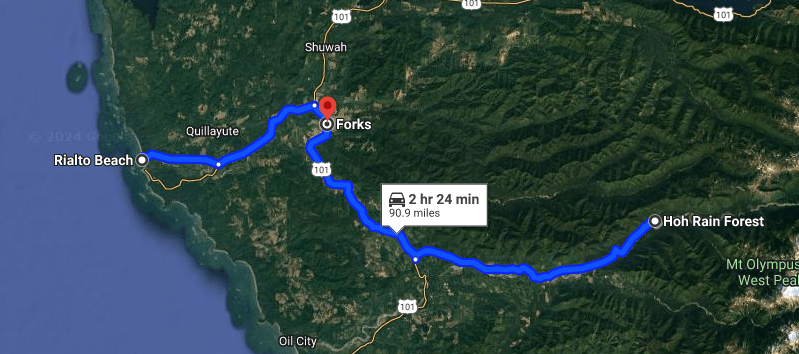
Day 4: Mora Beaches and Hoh Rainforest
Your day’s activities will depend on the tide chart, so check the schedule and plan your visit to Rialto Beach during low tide for the best tidepooling experience. Give yourself plenty of time to travel to the beach and walk to your designated tide pooling spot, as you’ll want to make the most of your time exploring the shallow pools and seeing the marine life up close. Once you arrive, take a short hike to Hole-in-the-Wall, a stunning sea-carved arch, and explore the surrounding tidepools. The hike is about 1.5 miles round trip, and the scenery is breathtaking.
As you walk along the beach, keep an eye out for the unique rock formations, tidepools, and driftwood sculptures. And don’t forget to look for wildlife, including sea otters, seals, and over 300 species of birds.
If you have time, consider exploring some of the other beaches in the area, such as Second Beach and Third Beach. Each one has its unique character, and they’re all worth a visit. Please note that parking for these two beaches is limited and mostly street-side and the paths are not as easy to traverse as at Rialto.
After a fun-filled morning exploring the Mora Beaches, head to the Hoh Rainforest. Hike the Hall of Mosses Trail and the Spruce Nature Trail.
Depending on tides, you may want to visit the rainforest first and then the beaches on your way back to Forks to spend your second night. The day is heavily scheduled and your will need to keep tide schedules, lunch, and peak rainforest visit crowds in mind.
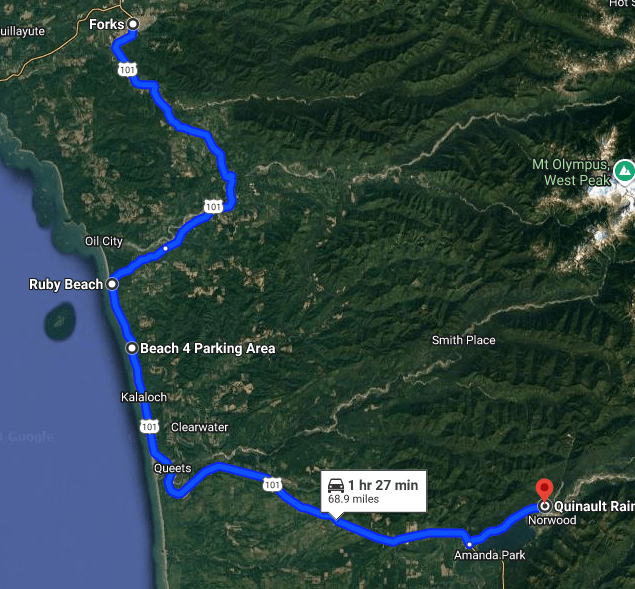
Day 5: Kalaloch Beaches and Quinault Rainforest
On your final day visiting Olympic, visit the stunning beaches of the Kalaloch area. Once again check the tide schedule to plan your day. Start with a visit to Ruby Beach, where you can see the unique rock formations and tidepools. Take a short walk to the beach and enjoy the scenery. If you have time, visit Beach 4, known for its excellent tidepooling opportunities.
After exploring the beaches, head to the Quinault Rainforest, one of the largest temperate rainforests in the United States. Take a short hike on the Quinault Rainforest Trail, which takes you through a stunning old-growth forest.
Waterfall lovers will want to include some of the area’s easy to reach falls. The Gatton Creek Trail is a great option, which takes you on a 0.6-mile hike to a stunning waterfall. Don’t miss Merriman Falls, which is a short and easy walk from the road.
If you have time, consider visiting the Quinault Indian Reservation, where you can learn about the history and culture of the Quinault people. You can also visit the Lake Quinault Lodge, which offers stunning views of the lake and the surrounding forest.
Where to Stay in Olympic National Park with a Big Family
Olympic National Park Lodging Lodging Options
Located in the park, both the Log Cabin Resort and Lake Quinault Lodge offer accommodations suitable for families of six. Located on the tranquil shore of Lake Crescent, the Log Cabin Resort provides rustic two-bedroom cabins that allow six guests. These cabins offer comfortable living spaces and easy access to the lake, making them ideal for families looking to enjoy activities such as kayaking or simply unwinding by the water. Historic Lake Quinault Lodge, situated on the shores of Lake Quinault, also offers rooms to sleep six. The lodge offers a stunning backdrop of lush rainforest, providing guests unique opportunities for hiking and wildlife viewing right at their doorstep. Like most accommodations within national parks, rooms are typically priced at premium rates and often lack amenities such as televisions and Wi-Fi.
Olympic National Park Camping and RV
The park features 15 campgrounds offering various camping experiences ranging from primitive to more developed sites. Primitive campgrounds focus on providing a more secluded and natural experience with minimal facilities. Ten of the campgrounds accommodate RVs and trailers, boasting amenities such as flush toilets and potable water. Visitors can enjoy diverse landscapes, from oceanside and lakeside views to lush rainforests.
For those interested in planning a camping trip, check recreation.gov for reservations, as availability varies. While some campgrounds operate on a first-come, first-served basis, others require reservations during peak seasons to ensure a spot.
Vacation Rentals
Finding hotels to accommodate large families can be challenging in the Olympic National Park area. As an alternative, vacation rentals can offer more space and flexibility, often providing multiple bedrooms and kitchen facilities to suit your family’s needs. However, to maximize your visit, consider relocating your base as you explore different sections of the park. This strategy helps reduce long drives and allows more time to enjoy the park’s diverse attractions and natural beauty.
Local Hotels, Lodges, and Inns Near Olympic National Park
To fully experience Olympic National Park, consider booking multiple hotels around the park in Port Angeles and Forks (adding properties to our list). Changing your lodging location during your visit helps minimize travel times, reducing the need to backtrack at the end of the day and shortening morning commutes to start your exploration.
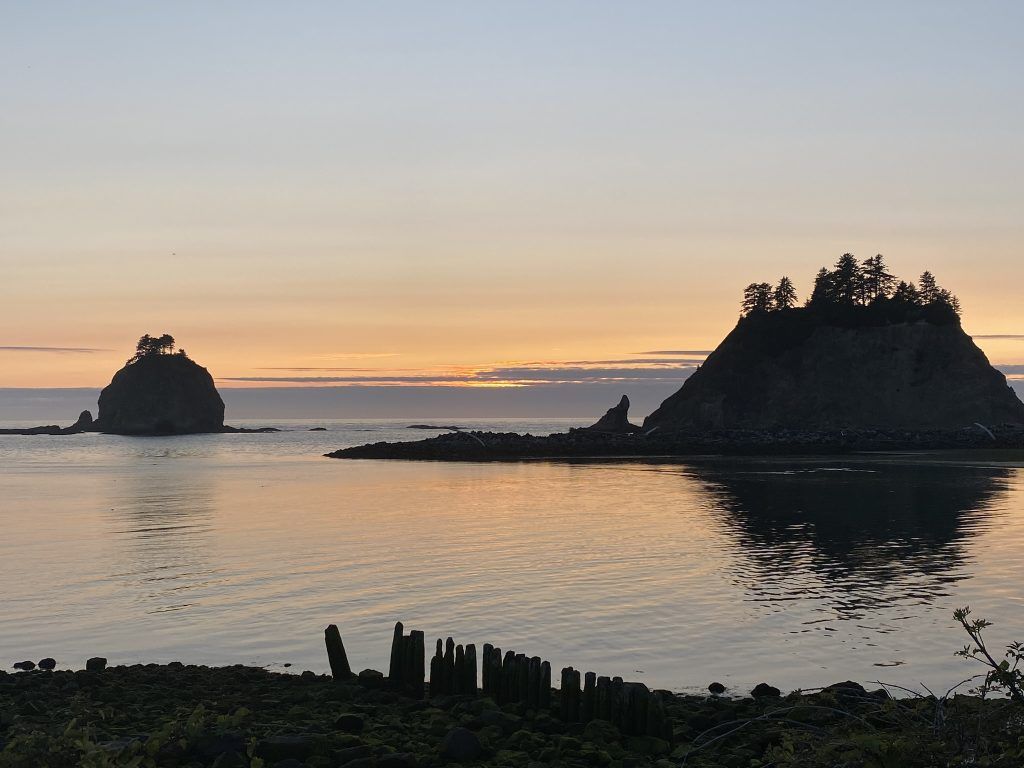
Tips for Planning Your Trip
Effective trip planning is key to making the most of your visit to Olympic National Park. Here are some tips to help you plan your trip and create a memorable experience for your family.
- Plan Around Tides: If tide pooling is on your itinerary, plan your visit based on the tide schedule. Check the dates for negative tides, especially if you want to explore areas like Beach 4, to ensure the best experience when marine life is most visible.
- Dress Appropriately: Prepare for changing weather by packing extra clothing, suitable footwear, and rain gear. Towels and a change of clothes can be handy due to mud and water on trails. Layering your clothing will help you adapt to varying temperatures throughout the day.
- Weather Flexibility: Smoky haze from forest fires or overcast skies can affect visibility. Aim to stay multiple days in each area and be flexible with your plans. Move sightseeing activities to clearer days for optimum views of the park’s stunning landscapes.
- Map and Connectivity Prep: Download or print area maps and hiking trails beforehand, as cell service may be unavailable in certain park areas. This will ensure you can navigate without digital assistance and stay on course.
- Time Management: If you’re short on time or want to avoid crowded spots like Hoh Rainforest, consider spending more time at the Quinault Rainforest. The less crowded Rain Forest Loop offers a peaceful alternative without the wait.
- Food and Supplies: Bringing packed lunches can save time and money; plan to dine out for dinners. Stock up on supplies at Safeway in Port Angeles or Thriftway Washington Food Store in Forks.
- Gear Up: Carry binoculars for wildlife viewing and consider a baby carrier or hiking backpack, as many trails are not stroller-friendly. A carpet mat tool is helpful to brush off dirt and sand from shoes before entering your vehicle.
- Educational Engagement: Before your trip, introduce your children to the park’s ecosystems by exploring books or videos about rainforests, wildlife, and the Pacific Coast. This will create excitement and enhance their understanding of what they see, making the visit more engaging and educational.
- Junior Ranger Program: Encourage your kids to participate in the Olympic National Park Junior Ranger Program. This interactive experience allows children to learn about the park’s natural and cultural history through fun activities. Completing the program earns them a Junior Ranger badge, a memorable keepsake from their visit.
- Daylight Planning: Check the local sunrise and sunset times before your visit to maximize your daylight hours for outdoor activities. This information will help you plan your hikes and sightseeing to make the most of your time in the park. As your day winds down, several points offer excellent sunsets. Hurricane Ridge, First Beach, Rialto Beach, Ediz Hook in Port Angeles, are great locations for viewing the sunset.
